Does Len'en stuff, a bit of translations and lore analysis. Big fan of the lores~ I've other interests too, but they'll show up when they show up :)
Don't wanna be here? Send us removal request.
Note
Do you have any opinions on the sorta-prequel to Len'en Emergency Everyday?
Opinions as in like, whether I like or dislike it? I can't say I have any strong feelings about it no, but then I rarely do lol.
I do appreciate it as the precursor of the modern Len'en as created by JynX, and I do think that some things about the modern Len'en can perhaps be traced back to EmEv, particularly much about the basic premise and character outlines of EE, making it interesting to study from that angle, but I ultimately consider the two Len'ens separate series, rather than one being a sequel to another.
As for how I personally relate EmEv to Len'en, it's quite tricky really, since all we know about EmEv is what we have from the old Laxpus website and the video of the game's demo, while JynX likely knew a bit more from their personal dealings with Daijin. I myself think of it as a separate game that the modern Len'en is rather heavily inspired by, but nothing more.
And yeah that's about it, using the archaeology metaphor for describing how I interact with Len'en which I love so much, the modern Len'en series is my core object of study, but EmEv is useful as a relic from a neighbouring civilization that we can use to draw parallels to Len'en in order to learn more about it.
6 notes
·
View notes
Note
What's the deal with how Sanra talks?
Sanra's Style of Speech
Right, so what is Sanra's style of speech? There's a short answer and a long answer, but let's check out the short answer first:
Roujin-go (老人語), "Elderly Language"
First off, I suppose I should mention the concept of yakuwarigo (役割語), "role language". Which is basically the idea that certain language features are used in media to signal certain character traits, although they can diverge from how said language features are used in real life or historically.
With that in mind, it's actually pretty easy to point out what Sanra's speech style is, because it's pretty much exactly an established type of role language: Roujin-go (老人語), "elderly language". As the name implies, it associates a character with being old, or at least old-fashioned.
This style of language has many features that can be traced back to the western Japanese dialects, particularly similar to the modern Hiroshima dialect. This association arose during the Edo period (1603 to 1868), where the center of power in Japan moved from Kyoto, in west Japan, to Edo (Modern-day Tokyo) in east Japan. Many powerful people from the region around the old capital, called Kinai (畿内), followed this move and settled in Edo.
Initially, Edo didn't really have its own dialect and so adopted the Kinai dialects as the standard. But as commoners started settling in and developing their own culture, a unique Edo dialect came into being, and thus the style of the Kinai dialects became associated with the conservative elderly and the educated elite.
From there theatrical performances would make use of exaggerating features from these accents to indicate that the character being acted is an elderly person, cementing the "elderly role language".
What this means for Sanra's character
For Sanra, within the context of Len'en, I highly doubt this is meant to indicate that Sanra is actually old by any measure. After all they're likely younger than Mitori, and Mitori talks in standard Japanese when they're not hamming up the emperor persona.
Instead, I would suggest that they imply Sanra is old-fashioned, at least in certain aspects (we know that they're not one for uniform rules though), or that they spend a lot of time with older people, possibly other high-ranking members of the military, picking up their speech along the way. In other words, that it ties to their military background the most.
Long Answer: A Dissection of Features
And that's the short answer. Next up, the long answer. It's nothing that will reframe everything that came before this, but rather just a dissection of the specific language features employed in Sanra's speech. So if you're not interested, that's all for now!
Otherwise, here's each of the standout features used in Sanra's speech:
1. First-person Pronoun: Washi (ワシ)
Description
The first-person pronoun washi (儂・私) is believed to come from a contraction of the "standard" watashi (私) pronoun. It has its origins in the Muromachi period (1336 to 1573) and is still in use to this day, though it is steadily on the decline.
Demographic
Washi originates from western Japan, and is used by men of all ages, although ore (俺) has been slowly eclipsing its use amongst the younger generations in modern days. As for women, it is not unheard of for them to use it either, though it is in general not as common nowadays. It should be noted however that its modern decline amongst younger generations has nothing to do with its association to the elderly in fiction.
Perception
In the regions in which washi is actually used, it ranges from carrying a neutral level of respect to actually being one to use when showing respect to whomever you're talking to. However, outside of western Japan, it can be perceived as rather unpleasant and crude, similar to ore (俺), and carries that association with elderly men.
In Fiction
The pronoun washi largely shares the same story as the elderly role language, where features of western Japanese dialects were adopted as signaling an elderly, authoritative character, such as the elderly or warriors. Nowadays, this perception persists, and the association with old men in particular is the strongest.
Use by Sanra
In Sanra's dialogue, washi is written in hiragana characters rather than kanji, like so わし. As far as I can tell this variation carries no particular additional meaning though.
Example:
JP: <わし>は『藤原 銀 讃良』 Romaji: <Washi> wa "Fujiwara no Shirogane no Sanra" EN: <I> am "Fujiwara no Shirogane no Sanra"
2. Dialectal Copula: ja (じゃ)
Description
I apologise for getting a bit technical here, but I can't think of another way to describe this. A copula is the part of a sentence that connects the subject to the object, like the verb "to be" in English.
The copula ja (じゃ) comes from dearu (である), which got shortened into dea (であ) and later into ja (じゃ). It serves the same purpose as desu (です) or da (だ), making a sentence declarative, i.e. providing information about something. For example:
JP with ja: これはワシの本じゃ (Kore wa washi no hon ja) Standard JP: これは私の本です (Kore wa watashi no hon desu) EN: This is my book.
Demographic
Ja is localised to the Chuugoku region of western Japan, specifically in the Okayama dialect (岡山弁) of Okayama prefecture. I couldn't find much more about what specific demographics use it (though anecdotally it seems like men use it more), nor whether its use is in decline or not.
Perception
To be completely honest I couldn't find much on its perception in actual use, though I would imagine that with its proliferation in media, the association with the elderly is found in reality as well.
In Fiction
The copula ja again shares the same story as the elderly role language, and came to be associated with the elderly. Nowadays, this perception persists.
Use by Sanra
In Sanra's dialogue, ja is used as one would expect, and nothing particularly stands out.
Example:
JP: 陛下の命はこの都で最も貴重なもの<じゃ> Romaji: Heika no inochi wa kono miyako de mottomo kichou-na mono <ja> EN: Their Majesty's life <is> the most valuable thing in this entire city.
3. Sentence-ending Particle: nou (のう)
Description
The sentence-ending particle nou (のう) traces its roots back to the medieval particle nau (なう), roots that it shares with the more commonly seen ne (ね) and na (な), which is reflected in their similar usage.
Entire papers can and have been written on how such particles are used, so I can't possibly explain it adequately here. But in general, they are emphatic particles, little bits of language which convey emotion or add nuance to a sentence, be it surprise, frustration or what else have you, all with the same little particle.
Demographic
Nou is now mainly used in western Japan, again, particularly in the Kishuu dialect (紀州弁) of Wakayama Prefecture. I couldn't find much more about what specific demographics use it, nor whether its use is in decline or not.
Perception
I again couldn't find much on its perception in actual use, the pronouns have a lot more weight in perception judgements like these, leaving smaller particles on the wayside. I have been able to find that some regions consider nou and na to be pretty similar, performing the same function, though whether it's more or less refined than na fluctuates.
In Fiction
The copula nou again shares the same story as the elderly role language, and came to be associated with the elderly. Nowadays, this perception persists.
Use by Sanra
In Sanra's dialogue, nou is used as one would expect, written both as のう and as のぅ, the only difference being whether the う is small or not. Though this makes no real difference in its meaning.
Example
JP: 侵入者がたったの三人だけとは思わなかった<のぅ> Romaji: Shinyuusha ga tatta no sannnin dake to wa omowa-nakatta <nou> EN: But I <sure> didn't expect there to only be three intruders.
4. Negation: nu/n (ぬ・ん)
Description
The most common form of negation in standard Japanese is with nai (ない), e.g. 書かない (kaka-nai) for "do not write". However, prior to this, nu (ぬ) was used instead much in the same manner and to the same effect, e.g. 書かぬ (kaka-nu), which can also be abbreviated simply into n (ん), e.g. 書かん (kaka-n).
Demographic
The nu/n negation is nowadays mainly used, once again, in western Japan, and the story repeats itself. It can be used by all people, but is seeing decline in modern days. Again, its modern decline is unrelated to its association with the elderly in fiction.
Perception
I again couldn't find much on its perception in actual use.
In Fiction
The nu/n negation also shares the same story as the elderly role language, and came to be associated with the elderly. Nowadays, this perception persists.
Use by Sanra
In Sanra's dialogue, both negation using nu and n are found, again used as one would expect, with nothing outstanding.
Example 1: nu
JP: 勝て<ぬ>か・・・ Romaji: Kate-<nu> ka... EN: I could<n't> win…?
Example 2: n
JP: 相手になら<ん>と聞いておったが Romaji: Aite ni nara-<n> to kii-te otta ga EN: I did hear that [those Goefu mannequins] were <no> match for th' intruders, but…
5. Dialectal Verb: oru (おる)
Description
Oru (おる) is the dialectal version of the standard verb iru (いる), which can be described as the verb "to be/have/exist (for living beings)". In dialects where oru is used, it replaces all cases of iru, even in cases like te-iru (ている) for the progressive tense, where it would instead be te-oru (ておる).
Demographic
You guessed it, oru as a dialectal variation of iru is used in western Japan. I couldn't find much more about what specific demographics use it, nor whether its use is in decline or not (though anecdotally this one seems to be holding on quite well).
Perception
There's not much difference in how oru is perceived as compared to iru. Though it should be noted that, while in standard Japanese, oru is actually the humble form of iru, it is not considered so in these dialects.
In Fiction
On its own, oru seems to have avoided the elderly association in fiction, perhaps due to how ubiquitous it is in western Japan. Instead, it typically simply signals a person being from the Kansai region. However, when appearing alongside the previous features, it contributes to the signaling of an elderly image all the same.
Use by Sanra
In Sanra's dialogue oru is again used as one would expect, with nothing outstanding.
Example
JP: 我らの都に攻め入って<おる>んじゃ? Romaji: Warera no miyako ni seme haitte <oru>n ja? EN: [...] you three invadi<n'> our capital city?
Conclusion
And that's all 5 standout features used by Sanra in their speech, all from the "elderly role language".
To recap once more, they are:
First-person Pronoun: Washi (ワシ)
Dialectal Copula: ja (じゃ)
Sentence-ending Particle: nou (のう)
Negation: nu/n (ぬ・ん)
Dialectal Verb: oru (おる)
All in all I believe Sanra's use of the stock "old person talk" is meant to relate to their time in the military, perhaps due to them spending a lot of time with the older, high-ranking members of the army.
Alternatively, it could be showing that they're more of an old-fashioned person, which in some senses is true, despite them representing the "new" in the "old vs new" clash they and Kaoru have going on.
Ending
And that's finally all I have, first post in a good long while and it's a long one dang.
I apologise if my explanations for the linguistic features got more and more technical and ambiguous as the list went on. They're not nearly as discussed as the first-person pronouns and much harder to both do research on and explain.
It is always the simplest-looking bits of language that are the hardest to explain, and I've elected to avoid really going into the nitty gritty of semantics and grammar, since I'd imagine you're more interested in the indexed meaning rather than the practical application of these language bits.
I suppose I should finally note that I am, of course, not Japanese myself, and thus ultimately unfamiliar with how things actually are on the ground in Japan. So it's more than possible that I've missed some things, but still I believe that this is at least suffice to get a surface grasp on the central question of "What's the deal with how Sanra talks?"
As usual, I hope you enjoyed~! :)
10 notes
·
View notes
Note
So what's the deal with everybody's favorite spoopy mirror Mitsumo?
It's been a while since my last post, hasn't it? I'm glad to be back doing another one
I've been busy with my Len'en Tweet Collection project recently, a thorough translation of all tweets related to JynX and Len'en! Check it out if you'd like, but it is mainly just for archival purposes, any info will be logged on the Len'en wiki eventually.
Now! Back to our topic of the day. One might think that there won't be much going for this stage 1 boss, especially since they don't even contribute to the world-building much, unlike Souko.
I thought that would be the case as well, but as I did my research, I found that there's actually still quite a bit to go through with them. So, let us take a dive into this silly-looking mirror and their tagalong!

Visualized Mental Scars — Mitsumo (and Terumi!)
Name: Mitsumo
The name Mitsumo (照雲) is a simple one, comprised of two kanji meaning "illuminate" (照) and "cloud" (雲) respectively.
These are likely taken from the first kanji in shouyoukou (照妖鏡) and ungaikyou (雲外鏡) respectively, the type of object Mitsumo is/inhabits, and the youkai Mitsumo is based on. More on them later.
Name: Terumi
Terumi (輝美), Mitsumo's little tagalong, also has a simple name, the two kanji meaning "shine" (輝) and "beauty" (美) respectively. This name is also a pun on the Japanese word for "mirror", kagami (鏡), as the two kanji can be read as kaga and mi respectively.
Background: Evil-illuminating Mirror
The only concrete piece of information we have about Mitsumo, is that they are a "evil-illuminating mirror" youkai.
An "evil-illuminating mirror" (照妖鏡 CN: zhàoyāojìng JP: shoumakyou) refers to enchanted mirrors originating from Chinese legends that are able to reveal a youkai's true form or magic.
In Japanese tales, they're more often known as "demon-illuminating mirrors" (照魔鏡 shoumakyou) or "youkai-felling mirrors" (降妖鏡 gouyoukyou).
And that's all we know about Mitsumo. Notably, it's not even clear whether they are the mirror itself or a spirit inhabiting the mirror.
Abilities
Project Trauma
Mitsumo is known to have two major abilities, chief amongst them is their ability to "project trauma".
The verb used in the original Japanese is utsusu (映す), which refers to the action of a mirror capturing a reflection and showing its image upon its surface. But also to project something, like onto a TV screen or onto a wall.
So we can surmise that Mitsumo is able to show whoever looks into them their greatest trauma, destroying their minds and taking them over as a vessel.
When this happens, that headband with the tiny mirror apparently manifests on their victims head, and Mitsumo gains total control over them. This is needed because, being a mirror, Mitsumo cannot move by themself much, and thus requires assistance.
Producing Clouds
As we can see in BPoHC though, Mitsumo and Terumi ride on a tower of clouds to fly about and fight the protagonists.
This is revealed in a Kanae stream to be an ability they employ when they're getting ready to fight, as it allows them quick escape should their vessel get struck down in battle.
However, this apparently consumes much youkai energy, so Mitsumo prefers to avoid using it if they can.
Mythological Basis: Ungaikyou
Mitsumo is likely based on the ungaikyou (雲外鏡 mirror beyond the clouds), a youkai first seen in the 18th century artist Toriyama Sekien's Illustrated Bag of One Hundred Housewares (百器徒然袋).
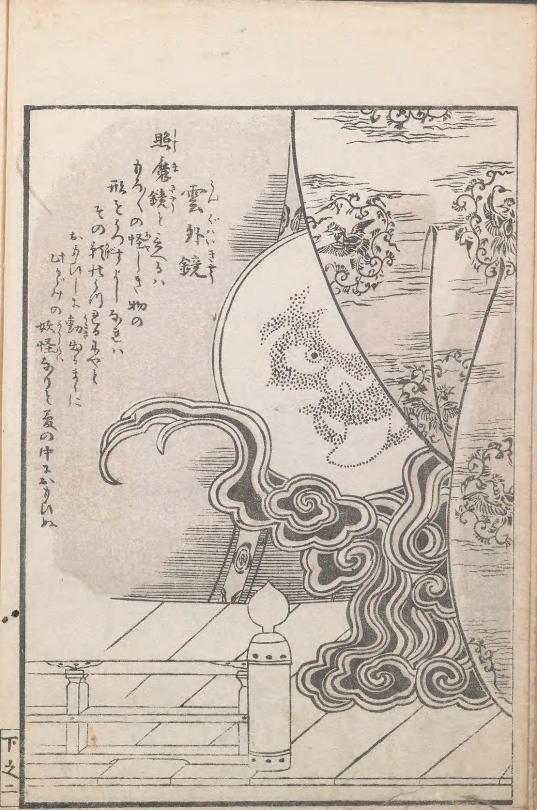
Above: Toriyama Sekien's illustration of the ungaikyou
Not much is known about the original ungaikyou, not even what it can do, simply that it exists, at least according to Toriyama.
However, as you can see from the illustration, the mirror rests on a tower of clouds (or mirror stand that is designed to look like clouds), and has a rather silly face in the mirror.
This design is quite heavily reflected in Mitsumo, with the clouds they produce and the many eyes on the mirror.
Origins
The accompanying text for this entry reads:
In my dreams, I thought to myself, "The so called 'evil-illuminating mirror' is able to capture upon its surface the forms of various bizarre things, so when I think about what happens when its shadow is captured, what came to me was this youkai."
It is frankly unclear what Toriyama means by this, though what is agreed on is that this likely suggests:
This youkai is likely invented by Toriyama, if inspired by a dream.
This youkai is likely based on the evil-illuminating mirror.
Not much can be gleaned from this, so we could try turning to its name instead. Ungaikyou, the "mirror beyond the clouds".
It's been suggested that perhaps the name is a reference to the Classic of Mountains and Seas (山海經), read sengaikyou in Japanese. It's a classical Chinese text that notably features a great number of descriptions of Chinese youkai, over 350 of them.
Additionally, it's been suggested that the "beyond the clouds" bit of its name refers to the "clear skies", which is further a metaphor for how the evil-illuminating mirror is able to reveal the true form of things, unobstructed by illusions.
Abilities
While Toriyama does not give any description to what the ungaikyou actually does, later writers have expanded upon the youkai and gave it a variety of somewhat similar abilities.
In the 1997 Dictionary of the Monster (幻想動物事典) by Takumi Kusano (草野巧), he gives the ungaikyou the ability to "show humans the image of a youkai they could become".
In the Illustrated Compendium of Youkai (図説 妖怪辞典) by "Youkai dot com" (妖怪ドットコム), the ungaikyou is given the ability to "control other youkai whose form has been reflected in the mirror".
These two abilities can be seen to combine into Mitsumo's ability, showing whoever peers into them a horrifying sight and then taking over their body.
Nature
As mentioned, there's not much we can tell from Toriyama's original depiction, but many later interpretations group it, and in fact every youkai in this book, into a group of youkai known as tsukumogami.
The word tsukumogami (付喪神 gods/spirits that posses [things that are] ruin[ed]) has been applied to applied to many different things, so what it specifically refers to isn't exactly 100% clear-cut.
In general though, the modern understanding is that they are objects that have existed for 100 years and thus become alive, gaining a spirit of its own.
For the most part, modern interpretation of the ungaikyou considers it a tsukumogami, often of an evil-illuminating mirror.
While there are 2 major examples that differ from this, they clearly do not relate to Mitsumo, so I've elected to omit them.
As far as I can tell, there's nothing that directly indicates that Mitsumo is actually an ungaikyou, let alone a tsukumogami, so there's nowhere we can really go with this, unfortunately.
Mini Theory: What is Mitsumo?
I have a small, not very substantiated theory about Mitsumo that I thought I might as well share anyways.
This theory is based on 2 major facts:
Mitsumo seemingly has a torii shrine gate with them, though warped in a malicious direction, judging by the horns.
Mirrors have long been objects of worship in Japan, popular as shintai, an object in which the gods' spirits dwell, at Shinto shrines.
My little theory goes, that Mitsumo was once worshiped as some sort of god, likely thanks to them being an evil-illuminating mirror, helpful in combating youkai and dispelling evil.
Mitsumo could have been a god that dwelled in the mirror, or they could simply be the mirror's own consciousness once it got old enough and gained a spirit.
Nevertheless, when worship of Mitsumo eventually faded away, they felt betrayed by his followers. These negative feelings eventually boiled over, corrupting them and transforming them into a youkai.
It is, after all, often said that youkai and gods are two sides of the same coin, the difference being only in whether they're worshipped by humans or not. Sometimes, one being can even be both at the same time.
That's all this theory is, that Mitsumo was a god whose worship faded, their resentment towards this transforming them into the malicious youkai that we know today.
Ending
And that's all I've got on Mitsumo, not a lot, but not little either.
They're a rather straight-forward character, all things considered, and yet they still have an air of mystery about them, it's the wonderful charm of Len'en, really. Let's hope that we'll get to learn more about them in the future~!
As usual, I hope you enjoyed~! :)
#len'en#len'en project#len'en lore#mitsumo#I had a lot of fun researching for this!#it's been a long while so perhaps I simply miss it#here's hoping my next break isn't this long#but if is then ah well
26 notes
·
View notes
Text
Getting into Len'en Lore: Part 1
Cause I mean there's a lot of it, isn't there?
With the 10th anniversary coming up I thought it might be nice to share my personal recommended reading order(?) for all the Len'en material, for people who really want to dig into the lore.
Of course, I'm sure most folks reading this are already neck-deep into the lore swamp but hey, on the off chance that it reaches someone new, right?
Getting the information in English
To start off, you'd either have to learn Japanese, or find a good translation for the series and its associated materials. Here I'll go with English, since it's, well what I'm writing in.
The Len'en wiki, for 99% of all cases, will absolutely be where you want to go to read up on the lore and translation of Japanese material.
All of the translations on the wiki have been diligently worked on by me and other brilliant translators, and even now we revisit old translations to polish them up, so I guarantee it's quality (I suppose there's no reason to trust me, but I do promise).
Now the wiki also has links to English patches for all 4 of the shmup games, if you'd prefer to read the dialogue in-game, though I must note that they won't be the most updated version of the dialogue, and have further paraphrasing to trim things down to fit textboxes.
Still, they're more than enough for getting a basic understanding of the plot, and the visual elements of the game are not to be missed out on, so do give the games a go!
The Reading List
Now that the preamble is over with, let's actually get into my recommended order for lore-exploration. Forewarning: It's a lot, so brace yourself for some good old reading.
Major Entries in Release Order
The first place to start is of course each of the series entries in release order, though there are some curiosities about how this series tells its story through changes to the games itself, so I'll walk you through those as well.
These are separated into "story reading order" and "additional reading", the first ones are pretty much necessary to, well, understand the story.
Additional reading, on the other hand, are not as crucial to grasping the story, and will be ordered from most important to least.
They often contain little tidbits of lore tucked within, and are fun reads perhaps only for fans of JynX writing or those who really want to dig deep.
Game 1: Evanescent Existence

We of course start with the first game in the series, Len'en Mugenri ~ Evanescent Existence (often abbreviated as EE in English).
Story Reading Order
Prologue
Yabusame Houlen's story — Main Story → Bad Ending → Good Ending → Extra Story
Tsubakura Enraku's story — Main Story → Bad Ending → Good Ending → Extra Story
Official Profiles
Additional Reading
Music Room Comments
Spell Cards
Documentation Pages — omake.txt, manual.txt, readme.txt, readme.txt (trial ver.)
Note: Bad Endings Bad endings are non-canon in all of the games, in the sense that the events depicted within haven't actually occurred. They're still very useful to read as "what-if" scenarios though, since they actually provide a lot of interesting information.
Game 2: Earthen Miraculous Sword
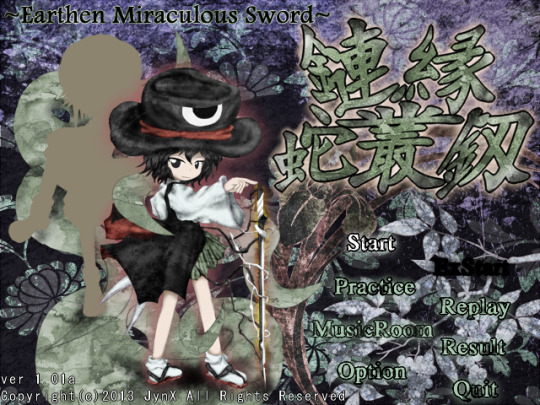
Moving onto game #2, simple enough. Here's Len'en Tasouken ~ Earthen Miraculous Sword (abbr. EMS).
Story Reading Order
Prologue
Main Story (Any character order is fine) — Yabusame Houlen: Story → Bad Ending → Good Endings A & B — Tsubakura Enraku: Story → Bad Ending → Good Endings A & B — Kuroji Shitodo: Story → Bad Ending → Good Endings A & B
Extra Prologue
Extra Story (Any character order is fine) — Yabusame Houlen, Tsubakura Enraku, Kuroji Shitodo
Official Profiles
Note: Good Endings A and B The two endings differ only in a single textbox at the very end, so no need to read it twice, just jump to the very end to see the difference. Or honestly, since it doesn't affect the story at all, you're free to just read either one and be done with it.
Additional Reading
Music Room Comments
Spell Cards
Documentation Pages — omake.txt, manual.txt, readme.txt & readme.txt (trial ver.)
Note: On the EMS Documentation Pages EE and EMS were actually released at the same time, as a result some files are unnecessary to read. ・omake.txt: Only different in the game title ・readme.txt files: Identical in every way in the trial version The manual and readme files are however different, so give them a glace if you'd please.
Game 3: Reactivate Majestical Imperial

Onto the 3rd entry: Len'en Reiretsuden ~ Reactivate Majestical Imperial (abbr. RMI). This game first introduces the team system, so each story features 2 playable characters.
Story Reading Order
Prologue
Main Story (Any team order is fine) — Shrine: Story → Bad Ending → Good Endings A & B — Bottle Opener: Story → Bad Ending → Good Endings A & B — Slaver: Story → Bad Ending → Good Endings A & B
Extra Prologue
Extra Story (Any team order is fine) — Shrine, Bottle Opener, Slaver
Official Profiles
Note: Good Endings A & B This time, the two endings have more differences, stemming from a slightly different outcome of the main scenario. So I'd personally recommend giving both a read. Though to be fair there's no functional difference between the two in terms out final outcome. So I wouldn't say that you must read both to understand the plot or anything.
Additional Reading
Music Room Comments
Spell Cards
Documentation Pages — manual.txt & readme.txt
★ Len'en Kanji Change

It is while working on the next entry of the series that JynX decided to change the kanji "Len'en" is written with, from 鏈縁 to 連縁, changing the first character, as you can see above.
There's actually quite a bit to read about this, though since it doesn't relate to the story, I'll just mention that this happened for now, more on this later. Onto the next game!
End of Part 1
This actually got so long that I couldn't fit it all in one post, so let's end things here and move onto part 2!
43 notes
·
View notes
Text
Getting into Len'en Lore: Part 2
Let's get straight back into it!
Game 4: Brilliant Pagoda or Haze Castle

And here's the 4th entry, the game of all time, Len'en Ten'eisenki ~ Brilliant Pagoda or Haze Castle (abbr. BPoHC).
This game retains the team system, but also adds a route system, and brings back every character introduced so far. So there's a lot of dialogue to go through.
Story Reading Order
Prologue
Demo Version Dialogue
Tutorial
Shrine Team's Story (Haze and Brilliant can be swapped) 4.1. Haze Story → Haze Ending 4.2. Brilliant Story → Brilliant Ending 4.3. Neutral Story → Bad Ending → Good Ending 4.4. Extra Story
New Emperor Team's Story (Haze and Brilliant can be swapped) 5.1. Haze Story → Haze Ending 5.2. Brilliant Story → Brilliant Ending 5.3. Neutral Story → Bad Ending → Good Ending 5.4. Extra Story
Official Profiles
Preschool Team's Story (Haze and Brilliant can be swapped) 7.1. Haze Story → Haze Ending 7.2. Brilliant Story → Brilliant Ending 7.3. Neutral Story → Bad Ending → Good Ending 7.4. Extra Story
Scoundrel Team's Story (Haze and Brilliant can be swapped) 7.1. Haze Story → Haze Ending 7.2. Brilliant Story → Brilliant Ending 7.3. Neutral Story → Bad Ending → Good Ending 7.4. Extra Story
??? Team's Story (Haze and Brilliant can be swapped) 7.1. Haze Story → Haze Ending 7.2. Brilliant Story → Brilliant Ending 7.3. Neutral Story → Bad Ending → Good Ending 7.4. Extra Story
Note: On the BPoHC Reading Order You might notices that the official profiles are in between the main story routes this time. Let me briefly explain my thought process: The Shrine and New Emperor team's stories are what I personally think are the "main stories" of the game, while the Preschool and Scoundrel teams act moreso as supplementary material. Therefore it'd be useful to have read the official profiles first beforehand to see easier understand what the "sub-stories" are talking about. As for the ??? team, also known as the Secret team, they're unlocked after beating the Ex+α stage with all the other teams, so they're clearly meant to be experienced last. To be honest, this game really is a lot. So I can't guarantee that this is the best order. If you don't mind, gimmie some feedback so that I can refine it!
Additional Reading
Music Room Comments
Spell Cards
Upgrades
Achievements
readme.txt
Games 1-3: EE to RMI Update

Above: Title screen of the updated EE, note the change in the first kanji, now it's 連.
After BPoHC, JynX went back and updated the first three games, rebalancing the games, changing the title to use the new kanji for Len'en, and most importantly, adding a ??? team character as a new playable in all three games.
It doesn't really matter which order you experience these in, just know that chronologically, the RMI scenario takes place at the same time as everyone elses, while the EE and EMS scenarios take place after BPoHC.
Story Reading
??? EE Story — Main Story → Bad Ending → Good Ending → Extra
??? EMS Story — Main Story → Bad Ending → Good Ending A & B → Extra
??? RMI Story — Main Story → Bad Ending → Good Ending A & B → Extra
Note: Story Structure Everything I've said about the story structures about the first three games still apply here, so bad endings still don't actually happen, the two good endings in EMS are almost identical while the ones in RMI have more differences.
Album 1: A World That Isn't Fantasy [Frontside] and [Backside]

Next comes the series' first album collection, A World That Isn't Fantasy ~Len'en Mugenri~ (abbr. AWTIF), it's separated into 2 albums: [Frontside] and [Backside].
You can listen to and purchase the albums on bandcamp:
World That Isn't Fantasy [Frontside] ~Len'en Mugenri~
World That Isn't Fantasy [Backside] ~Len'en Mugenri~
This is the only way to obtain the digital booklets that come with the albums, though the text within is publicly available for translation, and thus translated on the wiki, images are off-limit.
Despite being an album, even this has quite a bit of reading material, so here we go:
Story Reading Order
Backstory to albums' in-universe creation — Summarized on the wiki, but information comes from: ・"Mugenri Revitalization Committee" Twitter list ・Len'en Project 5th Anniversary Video! album announcement
Booklet Content — Short Story — False Spirit Account
Additional Reading
Unlike the games, the album doesn't come with music comments. Instead, JynX released comments on the new tracks on pixiv FANBOX, which can be read here:
An Endless Beginning & Virtual Parallel Universe
Ivory Cup ~ Cup of Eibon & ■|ack◆0x・uG
Today is the Day We Duel for Real! & A World Lacking of You
Alice Leaping Atop Lily Pad Ice & To Mugenri
End of Part 2
There is... so much, to this series that only has 4 games and some change in it. This is honestly already enough for you to start, the next and final part will just be on the spinoff game and to wrap up some obscure stuff.
So if you don't care about that, or just don't want to get overwhelmed by what else there is right now, you can start your journey already.
14 notes
·
View notes
Text
Getting into Len'en Lore: Part 3
This'll be the end!
★ Spinoff Game: Book of the Cafe

Curious title screen, isn't it? You can't even see the game logo yet! JynX said that it'd be revealed one day, but until then, here's the 5th released game in the series, though officially it's the 0th game.
This is Len'en Cafe ~ Book of the Cafe (abbr. BotC), and is the mobile social network game that JynX is actively working on at the moment.
Story Reading Order
The game's story is separated into three sections, the Main Story, Sub-stories and Back Issue stories. There's no particular order between these three, so I'll only list the order within each of them:
Main Story
Opening
Tutorial
Chapter 1
Back Issue Revisit past games' stories, learning new information about them!
EE — Yabusame Houlen's Route
EE — Tsubakura Enraku's Route
Sub-stories None exist yet.
Additional Reading
There's a lot of non-plot, and even non-lore related text in this game, here I'll list the pages that have major flavour texts and such. Though feel free to explore the BotC pages to learn more.
Compared to the other 4 games, these aren't nearly as crucial, and are more just fun reads. maybe with the exception of the 1st item.
Skill Names and Flavour Text
Music and Music Comments — Trioid Toykeat — Len'en Cafe ~ Re:Boot — Trioid Toykeat (ONAIR-version) — Mnemonic => Extraction — Infinite Zero-Point Ego Eris
Cafe design item descriptions
In-game Notices (α Version, β Version & Full Version)
Memory Archives stage descriptions
Items Descriptions
Other Important Reading, Videos and Characters
And that concludes all the reading you would need to do for all the series' main entries. Now for other important reading to supplement the main series entries:
Video: Critical Point Bidding its Last Farewell

Critical Point Bidding its Last Farewell, full title Fumbling Dimensional Tour ~ Breaker and Pursuer /* B-P-B */ Protection against Breach ~ Request Colorful Dreams, Detest Empty Illusions (yes it's that long), is a music video uploaded onto Niconico back before Len'en was even released.
It was unclear if and how it related to Len'en, but with the release of AWTIF, it became clear that the characters depicted in the video are the main characters of the albums.
Additionally, it introduces the "Wings of Magritte", an interdimensional transcending limited express train that gets a brief mention in BPoHC.
As for reading, I can't really introduce much of an original source for it, but its page on the wiki and the Wings of Magritte's page is recommended.
Reading: Interviews with JynX
There has been 3 interviews with JynX so far, all overflowing with lore, of course. A 4th one is currently in the works too, so look forward to that!
2015 Interview
2017 Interview
2021 Interview
Not much else to say about this one, just go check them out!
Reading: Peing
Peing is a Q&A social media platform where fans could've sent JynX questions back in 2019. JynX has since abandoned its use, in fear that it'd make information too scattered, but what was answered has been documented.
April Questions
February Questions
Videos: YouTube Videos

Above: Thumbnail of the second video featuring the androids, depicting Rei.
JynX also has a YouTube channel, run by the "Vtuber androids" Rei and Zelo (and Lin too), more on these three later.
The channel has official soundtrack uploads, videos about the androids and videos where the androids announce Len'en-related news. They'd mostly be to get a grasp on the android's personalities, I'd say, though there are lore scraps in there as well.
They're all translated up on the wiki, so go check them out here.
Characters: Monochroids (Rei, Zelo and Lin)

Above: From right to left, Rei, Zelo and Lin, all in their chibi yukkuri forms.
Specifically speaking, these androids are actually called monochroids. Despite them mainly having appeared in videos and on Twitter only, there's a surprisingly amount of lore to them, especially on Rei.
It's a much deeper rabbit hole than one'd imagine, so go check it out!
Reading Materials
Wiki page on the Monochroids
Wiki pages for Rei, Zelo and Lin
Other Minor Sources of Information
Once all that's exhausted, you should already be quite the lore master, I would wager. Though if you really want to go the extra mile, here's just a bit more for you to chew into.
Art: Illustrations by JynX

Above: The first explicitly Len'en-related illustration JynX ever made, released even before the character's own appearance in-game.
JynX occasionally does illustrations for various occasions, be it seasonal events or the Len'en anniversary. They sometimes come with little comments, which you can read here.
Events: Len'en Anniversary

Above: The 2nd anniversary's celebratory art, which, while not canon at all, comes with a few pieces of dialogue.
The Len'en series celebrates its anniversary on 11th November, not the day the games became available to the public, but the day JynX finished work on the first two Len'en games.
Often, JynX will release a YouTube video on the day, which we've already covered up above, but sometimes it'd be just an illustration instead, with some text to go with it.
All the anniversaries and their related celebrations can be seen here.
Blog: Unreal Indolence Record
This is JynX's old blog, the only real lore-related piece of information you'd find here is when JynX changed the kanji for Len'en, and even that's only tangentially related.
Though if you're interested, the blog is translated here.
Blog: pixiv FANBOX
Technically speaking, pixiv FANBOX is a monetization platform first and foremost, allowing fans to donate to their favourite creators. You can do so to support JynX too, and in return you'd get a sneak peek into upcoming Len'en content.
Additionally, JynX also uses its posting system as their new blog these days, and there are actually quite a lot of lore-related and adjacent information here, like the music comments I linked to previously.
They are translated and available for reading here.
Vtuber: Kanae Tabinoki

Yep, JynX is also a Vtuber! Their Vtuber persona is called Kanae Tabinoki, and have near daily streams where they usually work, chat or game.
Strictly speaking, they're not really related to Len'en, though being played by JynX, it's rather inevitable that scraps of lore slip through their mouth.
All lore scraps are documented on the appropriate page on the wiki, though if you'd like you can also read their page and summaries of their streams to look into the details.
Social Media: Twitter
Finally, we come to the end. There are 5 twitter accounts that are relevant to the Len'en series in one way or another. They are:
@mugen_Jinx: JynX's own twitter account
@TN_Rei: Rei and Zelo's shared twitter account
Now these two are absolute gold-mines of lore, back when JynX didn't really realise how crazy fans will get about the lore, they would just drop random scraps onto twitter.
They don't do it much anymore, probably for the same reason Peing isn't used anymore, but I've started a project where I collect and translate all JynX and Rei/Zelo tweets, for future posterity.
The project isn't complete yet, but what is there can be found here. I've already found all lore scraps and documented them onto the wiki though, so there's no urgent need to read these at all.
@EnHaL03472833
@3DM5r5AOnKN9RPN
These two are accounts belong to in-universe characters, and so in fear of spoiling things, I've left their names out.
Being much more important tweets, part of the overall narrative of the series, they have their own dedicated wiki page to translating them here.
@Kanae_Tabinoki: Kanae's twitter account
To be completely honest, in terms of lore, Kanae's account is barely relevant. He mostly uses it to announce upcoming streams. I'm just listing it here for completion's sake.
Final Note: On the Len'en Wiki
Like I mentioned in part 1 your best friend really will be the Len'en wiki, the primary sources and their translations on the wiki are 100% trustworthy, be it game dialogue, associated files or even tweet quotes.
Pages where information needs to be synthesised on the other hand I would be slightly more careful with, there's not a lot of us wiki editors so many of those pages remain un-updated beyond the bare minimum. Misinformation should be kept to a minimum, though.
However, I will guarantee the quality of the Origin and Name sections! I've poured many hours into research for those, and I'm quite proud of them.
Also, there's a glossary navigation box that has a lot of pages for terms, key items and organizations listed there.
I mention this cause while the characters and location navboxes are probably easy to come across, this one might be a bit more obscure. The Youkai page is one example where it can be found.
Finally, the Len'en kanji change and what it signifies is detailed on the Len'en Project page, specifically under Name and Concept & Story Arcs, so there's also that to check out.
Ending
And that! Concludes everything you have to know to start fully immersing yourself into Len'en lore, to the point where you can drown in it like I have.
There are also announced but yet unreleased games and things of the like, but you can explore the wiki to find out about them, or even just ask other fans!
I must reiterate, I wouldn't be too worried about learning and reading up on whatever I've mentioned here in part 3. Part 1 and 2 are already a lot, after all and they're really the main basis you need to dig into the lore, getting immersed in all that does kinda snowballs into the obscure stuff naturally though, so you'll be back~ :)
And finally, to be completely shameless, I do some pretty neat Len'en related analyses and theories here that I feel aren't quite solid enough for the wiki. So if you somehow manage to consume all this and still hunger for more, come visit, yeah?
Anyways, I really, really hopes this helps. And happy lore-ing~!
15 notes
·
View notes
Text
Musing on Ancient Mugenri History
I've been thinking about this topic recently and there's a lot in my mind, so I thought to write it down before it starts fading lol.
To be clear, this is going to involve a lot of speculation, and not much is gonna be based on concrete proof, which is a rather great departure from what I usually prefer, but hey, speculation is fun every now then~
This is gonna be split into several parts, which I hope makes things neat enough. In any case, let's begin!
The People of Mugenri
Before we look into the general ancient history of Mugenri, let's take a quick look at what the residents of Mugenri could've been like in the distant past.
Canon Information
First, let's start with the history of its population. Here, we look at these this line from A World That Isn't Fantasy — To Mugenri:
Hoojiro "Another world….. A land of a race that broke off from mankind long, long ago."
Haru immediately recognises this as referencing the "Land of Non-humans", which Tsubakura had apparently been looking into prior to being spirited away.
This land is generally accepted to refer to Mugenri, and this is the assumption I will be going off of here as well.
Additionally, let's also take a look at this bit of information from the 2021 Interview with JynX.
Characters (BPoHC) — Question 242 Q: Considering that God is moreso a qualification rather than a species, are Yago and Souko's longevity thanks to their original species rather than their status as a god? Does becoming a god even grant you new abilities? A: They both gained their longevity after becoming gods and were originally human-like.
Interpretation
Putting these two together, I propose the following: Mugenri was initially inhabited by a "primordial race", the very human-like race that Yago and Souko belonged to prior to their ascension to godhood.
Somewhere a long the way, this original race split into "humans" and "non-humans", who once co-existed peacefully but had a fall-out of some sorts.
This lead to the event Hoojiro described, the non-humans "breaking off" from the humans and settling in Mugenri, creating the "Land of Non-humans"
Caveats
There are, I think, 2 major caveats to this idea:
I'm making an assumption that the non-humans "breaking off" from the humans applies to both their evolutionary path as well as the relationship between the two.
There's nothing explicitly connecting the "human-like" race and the modern humans and non-humans.
Mugenri's Ancient History
This is where we get really speculative, as all I really have to go on are these names from BotC Back Issue EE Yabusame's Route - Stage 1:
Gods' Tabooed Land
Garden of Eden
Lost Horizon
Oppressed Land of Exile
It should absolutely be noted NiLU suggests that not all of these names originally referred to Mugenri, but that they only got conflated with Mugenri later down the line.
Nevertheless, they're helpful for taking a glimpse into Mugenri's nature. So, let's try to piece a timeline together using these names.
Step 0. Gods' Tabooed Land
"Tabooed Land" is a concept from Shinto that refers to a location said to be reserved for the gods and within which humans are forbidden, often believed to be where the gods descended to and from earth.
Admittedly, I'm unsure whether this step would be placed here or further down, hence "step 0".
If we were to place this here, this would refer to when the gods first descended to earth and started their work, landing in what would become Mugenri and creating "human-like" beings to inhabit it.
Step 1. Garden of Eden
This of course refers to the biblical paradise mentioned in Abrahamic religions where the first humans Adam and Eve once lived before being exiled by God for eating the forbidden fruit from the tree of the knowledge of good and evil.
It's a rather safe bet to place as the first stage of Mugenri, as it is where humanity originated. Paralleling, in the case of Len'en, Mugenri being where the human-like primordial race came from.
It would also be during this period that Yago Ametsukana ascended to godhood, and perhaps Souko Shirami as well, though I'm have less proof for that one outside of the two gods' basis sharing a similar time period in the irl myths.
I would guess that somewhere along the way, whether they have already speciated into human and non-humans aside, the original inhabitants of Mugenri got themselves exiled from Mugenri.
Fondly remembering the paradisical life they used to lead in Mugenri, and lamenting its lost, the land eventually became known as, or equated with, the name "Garden of Eden".
Side Note — Yago's Ascension You might be curious as to why I'm so sure that Yago's ascension is so likely to have taken place in this stage, even specifically before the residents got exiled. This comes from a spell card of theirs, Sword Shot "The Cherubim and the Whirling Sword of Flame". This spell references what the Abrahamic God sent to guard the Garden of Eden after Adam and Eve's exile. Thus, Yago having this spell card quite heavily suggests that it was the Ametsukana who forged the "whirling sword of flame" and sent it with the cherubim to guard the garden.
Step 2A. Lost Horizon
Lost Horizon is a 1933 novel by English writer James Hilton, famous for being the origin of Shangri-La, a fictional utopian lamasery.
Having been banished from Mugenri, and as the time passed, it's not beyond belief that the people (especially the humans) would've forgotten where Mugenri was once located, rending a truly lost location from their perspective.
It is also during this phase, I would guess, that the two categories of humans and non-humans must have came to be, no later than this. Explanation to come later.
Step 2B. Gods' Tabooed Land
Yep, the "Gods' Tabooed Land" returns once again. For those who did not forget Mugenri, where it was and its history; or perhaps from the gods' own perspective, Mugenri isn't "lost" at all, it's right there!
Instead, these people would've understood Mugenri as a place now exclusively belonging to the gods, and where humans especially are not allowed to enter.
(After all, while the line between human and god is fairly clear, that between youkai and god is often less so.)
Step 3. Oppressed Land of Exile
Unlike the other names, this one doesn't seem to be a reference of any sort, but is just a simple description of the land.
It is during this time period that I propose the "breaking off" between humans and non-humans must've occurred. For whatever reason, the two races were no longer able to peacefully co-exist.
This lead to the non-humans returning to Mugenri (like I mentioned, it's a lot more likely for them to know where it is after all this time). There, they either locked themselves within to cut all possible contact with the humans or they got locked within by the humans.
Having been exiled from the outside world, the inhabitants of Mugenri started a new era of their lives, adopting the Ruri calendar. "Ruri" meaning "exile", further strengthening this idea.
Side Note I've been using "Mugenri" to refer to this location this entire time, but it only makes sense to assume that this name isn't always what it was called. In fact, I think it's rather likely that it was only used after the barrier was created and a separate world formed. Here, I'll use "Ruri Mugenri", named after its Ruri calendar, to denote specifically the Mugenri as we know it now, separated from the outside by the barrier.
The "exiled non-humans" theory does raise a curious question though: Why are there also humans in Ruri Mugenri?
Of course, this could be explained simply by the fact that humans occasionally wander into Mugenri, but I get the impression that humans have always been in the Ruri Mugenri from the very beginning.
There are, in my opinion, three ways we can explain this:
These early humans were sympathizers to the non-humans, and in solidarity joined them in their self-imposed exile.
These early humans were those who sacrificed their own freedom to forever trap the non-humans in Mugenri.
These early humans were not interested in the race conflict, but was simply hoping to start anew or escape the outside world.
Personally, I would imagine that all these cases could be found, though I'd like to focus on the 2nd option. Because this, I believe, is the origin of the Senri Shrine.
We know that the 1st Senri priest was among those who created the Mugenri Barrier, and considering their successor, Tsurubami Senri's, stance towards youkai, it's not hard to see how I came to this conclusion.
Additionally, this also answers the question of whether the non-humans willingly shut themselves in Mugenri or were trapped in there by the humans.
This idea is somewhat supported by this from the 2021 Interview with JynX:
Mugenri — Question 86 Q: Can you think of Mugenri as a trap or prison, maybe a birdcage? Why else would it be so easy to get in but extremely difficult to get out? A: Something like that. The details are secret~.
Unhelpful JynX aside (lol), they did agree, to some extent, that Mugenri is a trap or a prison, further strengthening the idea that the non-humans aren't exactly willing participants.
The Human/Non-human Conflict
Finally, let's take a quick look at what could've caused this conflict between the two sides in the first place. I have a few theories, so let's go into that here.
First off, there's always the good old human fear of the unknown and the different, the easiest and most typical explanation for these situations and plots.
Perhaps the humans gradually grew more and more intolerant of the non-humans, and eventually took to taking up arms against them, leading to this conflict.
Of course, it's frankly hard to believe that these primeval humans would've been able to fight against the myriad of youkai and other non-humans all by themselves.
Here I suggest that the humans weren't alone, but were instead supported by a certain subset of gods. To see where this idea comes from, let's revisit A World That Isn't Fantasy, this time looking at Alice Leaping Atop Lily Pad Ice.
Hoojiro "Have you ever heard of it? The story of the imperial family and the Earthly Gods buried by history's darkness."
This is, at first glance, seemingly just a throwaway line. Hoojiro brings it up out of nowhere, and Haru quickly brushes her aside.
But even ignoring why Hoojiro brought it up, from an out-of-universe perspective, this line is far too loaded to be nothing, especially from a writer like JynX.
From an in-universe perspective, Hoojiro then follows this up with the talk on the Land of Non-humans in the next section, To Mugenri. This, to me at least, seems to hint that these two must be related somehow.
After all, Tsubakura was looking into the Land of Non-humans, and Hoojiro would've certainly had a good idea of everything they looked into and found.
So! Let's try to figure out what this is about.
First off, I'll tell you right now that this is referring to the mythologised telling of how the Yamato dynasty of Japan came to rule over these islands.
See the imperial family of Japan, according to their mythology, is descendant from Amaterasu Ōmikami, a sun goddess. She is what is considered a "heavenly god" (天津神 amatsukami), gods belonging to or originating from the heavenly realm of Takamagahara.
The counterpart to these heavenly gods are thus the "earthly gods" (国津神 kunitsukami), the native gods of the earth. They were the original rulers of the land (Japan), and it was through both diplomacy and force that the heavenly gods got the earthly gods to relinquish control of the earth to them.
This, I am certain, is the "story of the imperial family and the Earthly Gods", Hoojiro refers to. And I have a feeling that this is what caused the relationship between the humans and non-humans to sour.
Basing it on the myths, it would appear that the heavenly gods chose, for whatever reason, to side with the humans in the conflict, allowing them claim the world as their own.
Having identified the heavenly gods with the humans, this would leave the earthly gods with the non-humans, neither of whom fared very well in this exchange, and were forced to submit before the heavenly gods and their humans.
Thus the losers of this conflict, the earthly gods and non-humans, were "exiled" from the known world, put into an almost mirror-dimension-like plane of existence, their only way back out into the greater world through the outside, the Land of the Humans.
Note — Too Harsh on the Humans? History is written by the victors, or in this case, the imprisoned losers. All the sources we have so far are fairly Ruri Mugenri-centric, even those from outside. There is every chance that the humans were somewhat justified in their attack on the non-humans at first, perhaps the non-humans first took over and oppressed them, much like how the earthly gods were the original rulers of Japan. If this were true, that it'd be rather easy to see why the heavenly gods sided with the humans, perhaps out of pity, or a desire to use them to eliminate a common enemy.
Ending
Phew! That was a lot, wasn't it?
But this indeed concludes my thoughts on what the hypothetical ancient history of the land of Mugenri might be like, from it's initial inception to the establishment of Ruri Mugenri.
Like I mentioned at the beginning, a lot more guesswork and speculation this time, so its canonicity is very doubtful. Still, I think it's at least plausible.
As usual, I hope you enjoyed it~! :)
#len'en project#len'en#len'en lore#len'en theory#mugenri#I considered putting adding how tsukuyomi could've possibly fit into this too#but that just seems a bit too much#some other time perhaps
26 notes
·
View notes
Note
I've always wondered what was the deal behind 2 of Kuroji's spellcards: Front and Back "Three Traitors" and Backstab "The two-faced and the Judge".
Is there anything that could point to for what these spellcards are referencing. If not, I'd at least want to hear your thoughts on them.
A Pair of Mysterious Kuroji Spells
On Front and Back "Three Traitors" and Backstab "The Two-Faced and the Judge"
Below: Front and Back "Three Traitors" (Normal)
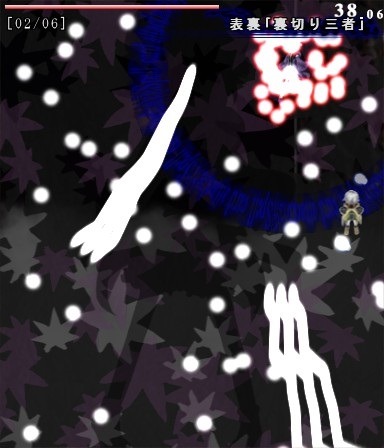
As far as I can tell, checking out both Japanese and Chinese sources as well, no one has actually come forth with any explanation as to what those could possibly be based on, if anything at all.
So instead, here's some of my own speculation!
Front and Back "Three Traitors"
Looking at it literally, Front and Back "Three Traitors" is of course a literal description of how the spell functions.
Three lines of bullets are shot out by Kuroji, and after a while they reverse in their travelling direction, attempting to "backstab" the player. Thus the three bullet lines are the "three traitors".
Of course, there's also the chance that it references something further, in real life or in the story of Len'en. Like I mentioned, I have no idea what it could be referencing IRL, so instead let's look at the latter line of thought.
I have two guesses as to what this could be pointing to:
1. The "three traitors" are Kuroji, Hooaka and Aoji
First, and perhaps the one that most folks would think of, is that the Mugenri Shitodo have "betrayed" Hoojiro in some way, making them the three traitors.
I say "betrayed" because judging by both how Hoojiro acts in AWTIF and how Aoji responds to Suzumi in BPoHC the two sides don't seem to entirely hate each other, and rather still care for one another quite a bit.
Perhaps it was a betrayal of trust or shared principles, but I don't think it would've been anything so great that their relationship had become irreparable.
Of course, there's also the chance that Hoojiro only "forgave" them after their disappearance, but that's getting a bit too speculative for me, so I'll leave it at that.
2. The "three traitors" are Suzumi, Suzumi and Suzumi
The other idea, is that this refers to Suzumi Kuzu, the three traitors thus referring to Hamal Cine, Arde and "Benny".
From the Scoundrel Team vs Suzumi dialogue in BPoHC, we can clearly tell that Suzumi once quite seriously betrayed the Shitodo (likely as well as Tsubakura, Yabusame and Clause; and maybe Kurohebi, though this one is ambiguous).
This idea fits the best into the spell title, at least using canonical information. Though frankly I find this the less likely option, especially since Kuroji shows little to no indication of knowing about the three Suzumis.
Backstab "The Two-Faced and the Judge"
Now this one is a lot more ambiguous, considering that this one is the hard/unreal version of the last one, we can try interpreting along my two theories from the last section.
1. If the traitors are the Mugenri Shitodo
Going by this one, the two-faced would of course be the three Mugenri Shitodo, and if I had to center onto any of them, it'd likely be Kuroji themself.
Out of the three, they're definitely the most likely to do, or even lead the other two to do, something that would lead to a "betrayal" of sorts, at least when considering their personality.
This would then of course place Hoojiro as the judge, and if the three really did do something to betray her, she would course then be the one to judge them.
2. If the traitors are Suzumi
This would of course placed Suzumi as the "two-faced", though technically speaking I suppose Suzumi is "three-faced". Perhaps Benny was just as reclusive as they are now?
In this case though who "the judge" is would be a lot more ambiguous. Tsubakura or Kuroji seem the most likely candidates here, Tsubakura being the main target of Suzumi's schemes and Kuroji being the creator of this spell card.
Personally, I lean towards Kuroji being "the judge" here, since to be completely frank Tsubakura seems to lack the assertiveness to really judge anyone, especially not with Suzumi.
In fact I'd say that Tsubakura seems quite unable to let Suzumi go, in a sense, if the Shrine team vs Ex+α Suzumi dialogue is any indication.
Like I said though I don't really think the Suzumi line of thought is the right one, but who knows~?
3. Kuroji is the two-faced? Or is Kuroji the judge?
The tricky thing with this name, is that unlike Front and Back "Three Traitors", there's nothing that seems to immediately link this name to the spell itself.
There are after all only two characters in the spell title, "the two-faced" and "the judge", while the spell prominently features three lines of bullets.
So instead, perhaps the characters in the spell title now instead refers to the player and Kruoji instead? But then is Kuroji the two-faced, making Yabusame/"Tsubakura" the judge? Or is it the other way around, making Kuroji the judge?
I personally lean towards Kuroji being two-faced in this case, though I have no actual reason for why other than a gut feeling.
Ending
And that's honestly all I have for this! Pretty much purely speculation and not much else. Still, I hope it's at least food for thought, or even just fun to read.
As usual, I hope you enjoyed~! :)
11 notes
·
View notes
Note
JynX mentioned that Buddhism is important to the Devanagara Royal Family. What sort of assumptions would someone from Japan make about the Royal Family (the customs, operations, ect) based on that?
(I know you're not Japanese but you do know Japanese mythology stuff and religion is kinda close to that, right? Sorry in advance if this question is too tricky, I'm just really interested in what could potentially be some lost common sense assumptions.)
Buddhism and Devanagara Court Culture
This is quite the tricky question, and there's a lot of history to go through, ones that I'm not all too familiar with. So all I can promise is that I'll try to find what I can.
What We Have in Canon
On Buddhism's Relationship With the Devangaran Court

I assume you're drawing from this question in the 2021 interview with JynX (Q117), which, I should clarify actually states the reverse of what you've mentioned.
Q: How strong exactly is the dominance of Buddhism in Devanagara? Does it have a privileged position established in the law? Are other religions accepted by the capital's residents? A: Buddhism doesn't really hold anyone in a special position outside of the sovereign family (imperial family), although the Department of Divinities and such do exist. Other religions are accepted as well, rather similar to modern Japan.
It says that "Buddhism treats the Imperial family specially", rather than the other way around, that "the Imperial family treats Buddhism specially".
Still, it's absolutely not a stretch to say that it's likely for Buddhism to be intertwined with a lot of the court's proceeding either, especially considering the numerous references to Buddhism in Devanagara as a whole.
Buddhism and Devangara as a Whole
So, let's first take a quick look at what we already have regarding connections between the two, which are mainly twofold:
One, the Imperial family seems rather fond of using Sanskrit, which is largely tied to Buddhism in Japan, we have:
Devanagara (Unclear, possibly देवनगर): "Holy Capital", also found on the Fujiwara dynasty's crown
Rudhira (रुधिर): "Blood"
Dhanya Nakta (धन्यनक्त): "Fortunate/Blissful Night""
To be clear, we aren't sure if the Devanagarans actually named the Rudhira, though considering they named both their capital and state-run casino in Sanskrit, its safe to say that they're quite fond of the language.
Two, Buddhism and the architecture of Devangara are closely related.
For one, buildings of religious and historical significance are preserved despite the rapid modernisation, this no doubt includes the Buddhist buildings of Devanagara, most notable the Pagoda of the Heavenly Mirror.
And secondly, the capital's popular architectural style seems to be styled after the pagoda of Buddhist origins, said to imitate the building in which the Buddha's remains, called śarīra.
Below: The common Devanagaran skyscraper and the Hōryū Temple's five-story pagoda, the oldest one of its kind in the world.

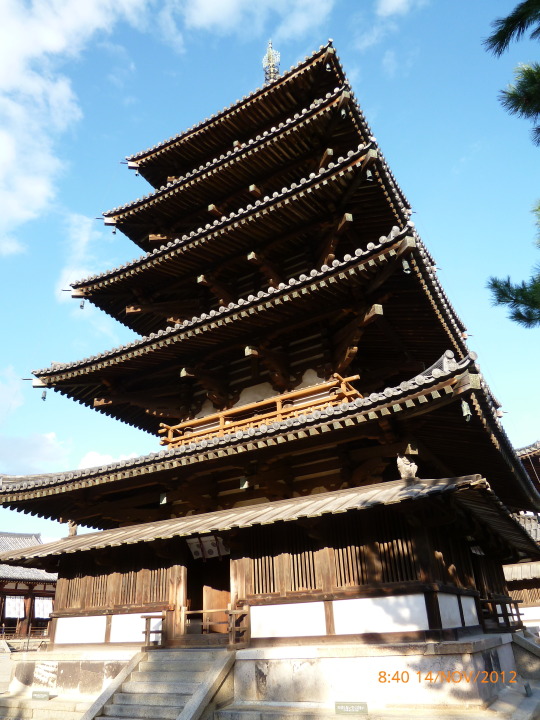
What the Audience is Meant to Take Away
To close off the first section, let's take a look at what I think (and I do stress "think", I'm not Japanese after all) JynX intended for the audience to take away from all this.
Firstly, I think you can be at ease that there's not much the average audience is really intended to "get", outside of making the observation that Devangara is heavily inspired by Buddhism.
Buddhist practices are of course very well known and observed in Japan, though I don't think you could quite extend this to mean that they'd know the religion in a very in-depth sense.
In other words, everyone, Japanese or overseas, is gonna have to do (perhaps even copious) amounts of research to really get JynX's elaborate references, so no worries there, we're all in the same, very confusing boat.
Secondly though, as far as I can tell, Buddhism seems to inform the aesthetic undertones of the city and its culture, but it does not seem to inform the city's system of government.
Why is Buddhism Not a Clue?
So this is turning out to be rather sour, isn't it? I do apologise for that. Still, there is more to go, and we can start with how I came to this conclusion:
What we now know as "Japanese Buddhism" and "Shinto" used to be very closely intertwined, almost treated as one thing.
Buddhism was introduced during the late Kofun period (552 to 538), and by the Asuka period (592/593 to 710) it had already been widely accepted by both the people and the imperial court.
While the specific details may vary, the two belief systems came to linked together as one, this is referred to by scholars as shinbutsu-shuugo (神仏習合), the "syncretism of kami and buddhas".
This lasted from the Asuka period, all the way up to the Meiji period, during the Meiji restoration.
Specifically, the Meiji government issued the Kami and Buddhas Separation Order (神仏判然令) in 1868, leading to the shinbutsu-bunri (神仏分離), the "separation of kami and buddhas", ending almost 1300 years of the two religions being treated as one.
The point of this story, is to realise that we're trying to retroactively and anachronistically apply a modern category of "Japanese Buddhism" onto a court system clearly modelled after that of Asuka or Heian era Japan.
As Buddhism and Shinto freely mixed back then, practices are rarely able to be traced back to either one specifically, or rather, it is because of this very mix that Japan's many unique customs and observances emerged.
In other words, JynX is able to be really creative and selective with what he wants Devanagara to be like. He could apply what has nowadays been extracted out of the old syncretistic system as Japanese Buddhism and simply apply that onto Devanagara.
Alternatively, he could get creative and mix in other elements as well. We actually already have one such example of this, the writing of Sanskrit in Devanagari.
Japan never adopted the writing of Sanskrit in its native script(s) (various Brahmi scrips back then), but rather, they either transliterated Sanskrit terms into kanji characters or simply translated the terms based on meaning (more often than not by borrowing their Chinese counterparts).
Yet we see, on the Fujiwaran crown for example, that Devangara in fact uses modern day Devanagari to write Sanskrit. How widespread this is in Devanagara is of course unknown, but its certainly something that you wouldn't find with Japan.
Why Buddhism is a Clue
I know I just did a whole thing explaining why Buddhism doesn't really work as a clue for us to figure out more about Devangara, let alone its court, but that's not entirely true either.
The information we have in canon about Buddhism and Devangara indeed doesn't tell us much, but we can use Buddhism's major presence in Devanagara as a small piece of a much bigger puzzle, and through it figure out what Devangara's imperial court could be mirrored after.
Ending
However, I do think that this answers the original questions.
"What is the average Japanese audience supposed to glean about the imperial family from the Buddhism's heavy presence in Devanagara?"
Honestly, nothing special. It doesn't tell us much about the imperial family at all, perhaps other than that they likely hold Buddhist beliefs as well.
Rather, it could tell us, if only a small bit, about the general culture surrounding Buddhism in Devangara. It's the main religion of the city, informing much of the city's culture and aesthetics, and it's highly respected by even the ruling class.
I think I'll also make a companion post to this one, explaining what one might be able to glean about Devangara's government using its ties to Buddhism as a clue.
I do apologise for ending it on a sour note, that this line of thinking just goes nowhere, but that is the conclusion I came to, and I'd like to be honest about it.
On a brighter note though, I must thank you for the ask regardless! It is precisely during my research for this post that I realised that the capital's ties to Buddhism can be used to further learn about its basis as a whole!
I hope the follow up will kinda make up for this one being a downer.
I do admit that even then it won't bring us much about the day-to-day culture of the imperial family though, since so much of court culture was dependant on religion and influence from China, Devangara is rather hard to apply it all to.
But until then, I hope you enjoyed this one all the same~! :)
6 notes
·
View notes
Text
Yago Ametsukana (Revisited)
My analysis on Yago Ametsukana was the first post I've ever made here, and while I still think it holds up to scrutiny 100%, I've since found a comfortable format in which to write these, so think it'd be nice to revisit and expand on it~!
And so, here's

A Thousand Blades and a Thousand Arms — Yago Ametsukana
Name: Yago Ametsukana
Given Name: Yago
Their given name, Yago (ヤゴ), is the Japanese word for dragonfly larvae, nymphs and naiads.
This is reinforced by its official Chinese rendering as 水蠆, which is also the Japanese kanji for the word and refers explicitly to the same things.
Family/God Name: Ametsukana
Their family name, Ametsukana (天目津金) is modelled after the names of Shinto deities, like those one would find in the Kojiki or Nihon Shoki, thus it takes a bit to analyse.
This name can be sub-divided into 3 parts:
First is "ame" (天目), the pronunciation along can refer to "the heavens", though further dissecting the name reveals that "a" is assigned specifically to 天, which means "heaven(ly)".
This can be deduced from the fact that "me" is a standard reading of 目, which means "eye". Taken as a whole, "ame" here combines to give "heavenly eye".
Secondly is "tsu" (津), the word literally means "harbour", though its often used in Shinto deity names for its pronunciation alone as an attributive particle, in other words, it means "of".
Finally is "kana" (金), which could mean "gold, metal or money", though considering Yago's occupation and domain likely means "metal"
Putting the three parts together, the name probably means something along the lines of "metal of the heavenly eye".
Curiously, this surname actually seems to be moreso Yago's title as a god rather than their name, as we see Yago invite Sukune to "become the next Ametsukana" in BPoHC.
Mythological Inspiration
Like a good chunk of Len'en characters, Yago is based on Japanese mythology, not just one such figure, but three! Let's quickly go over them here:
Shinto Deity: Ame-no-Mahitotsu-no-Kami
Firstly and most majorly, Yag is based on the Shinto god Ame-no-Mahitotsu-no-Kami (天目一箇神 lit. "Heavenly one-eyed god").
Below: The Usuno Hitotsume Shrine (薄野一目神社), one of the places where Mahitotsu is enshrined. (I couldn't find a traditional depiction of him so have this instead.)

Mahitotsu's Domain & Story
He is a god of metalworking and blacksmithing, of metalworkers and miners, mirrored by Yago's own domain of blacksmithing.
A god closely associated with him is Amatsumara (天津麻羅). He appears in the Kojiki, where he helps forge the mirror Yata no Kagami, used to lure the sun goddess Amaterasu out of hiding.
In fact, in the Kogo Shūi (古語拾遺), Mahitotsu is said to in fact have assumed the identity of Amatsumara during those events, and are thus the selfsame entity.
Perhaps this very event is what lead to Yago's contributions being acknowledged and their subsequent promotion to godhood.
The Hyottoko Mask
Also, Mahitotsu is sometimes said to be the origin of an archetypal character known as the Hyottoko (火男 lit. "fire man"), often acting as a comedic character during shrine festivals and other festivities.
Below: A typical hyottoko mask.

We see Yago themself wear the hyottoko mask on their head, as well as wearing the same headscarf a typical hyottoko mask wears over their eyes.
The 5-7 Paulownia Shrine Crest
As a final note, the most common shrine crest for shrines where Mahitotsu is worshipped is the 5-7 paulownia crest (五七桐紋), named so for the number of flowers on each cluster.
A stylised version of this crest is found in Yago's spell card background as well, no doubt a reference to their irl sites of worship.
Below: One of the layers of Yago's spell card background, featuring the stylised crest (most prominent to the left of Yago's head), with the standard version of the crest in the bottom-left corner.

Youkai: Ippon-datara
Yago is also based on the youkai ippon-datara (一本踏鞴 lit. "one-legged bellows"), who is often times said to in fact be the corrupted form of Mahitotsu after he fell from grace.
Below: An ippon-datara talisman, the specialty of Mastumoto Studio (松本工房), said to protect travellers, especially on mountains.
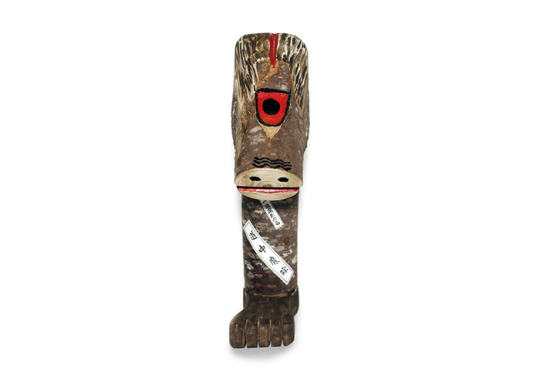
While tales and descriptions related to the ippon-datara vary greatly from region to region, they all generally agree that it is a fearsome being with a single leg, on which an eye as large as a dish sits.
Varieties aside, it's agreed upon that the "datara" in the name refers to tatara-shi (タタラ師), a type of blacksmith that works with Japan's historical tatara furnaces.
Based on this connection, the origins of the ippon-datara's two most consistent traits can be deduced:
It only has one eye as blacksmiths would've constantly kept one eye on the furnace, leading to its deterioration.
It only has one leg, as the other would've gone bad from working the bellows for so long.
This, by the way, would also be the same reason Mahitotsu is the "one-eyed" god of blacksmithing.
These are referenced in Yago's design as well, their left eye covered by a piece of headscarf and left foot modified to accommodate for how it had "gone bad from an occupational disease".
Shinto Deity: Kanayago-no-Kami
Finally, we come to their last basis, the Shinto goddess Kanayago-no-Kami (金屋子神 lit. "child-god of the metal house").
Right off the bat, we already note the inclusion of "yago" in her name, which is already interesting, but there is of course more~.
Below: A hanging scroll depicting Kanayago.

Kanayago is not the most consistent deity, at least in terms of her character details. She is most often said to be female, but is also occasionally cited as male.
She is sometimes said to be the same as Kanayamahiko-no-Kami (金山彦), or Kanayamahime-no-Kami (金山媛), or even Mahitotsu, all gods of mines and metalworking. Yet is other times simply a god that somehow relates to them, without explicitly being them.
What is consistent about her, is that she is a blacksmith, and is specifically a goddess of tatara furnaces, blacksmithing, fire and iron-making. These of course line up with Yago's domain quite well.
Kanayago is perhaps not as notable compared to Mahitotsu or the Ippon-datara, though I'm fairly sure that a connection exists regardless, if only a faint one.
Who knows? Maybe one day this connection will get expanded upon, and I'll get to tell you more about this goddess. (She's a very fascinating figure indeed, but that falls outside of our scope today.)
Sword: Sugari no Ontachi
Yago's goal in life is to one day make a weapon that's a perfect match for themself, but despite being a master at doing this for others, he simply cannot do so for himself.
Until that day finally comes, he instead uses the "Crested Ibis Sword", Sugari no Ontachi (須賀利御太刀).
Curiously, Yago's Sugari no Ontachi is said to be "the counterpart of another sword from the outside [world], and has lost its original owner and purpose".
We, of course, know nothing about its original owner or purpose, though the first part about it being a "counterpart of a sword from the outside" is indeed notable.
Counterpart Candidate #1: The Sugari no Ontachi
One candidate for this counterpart, is indeed, the Sugari no Ontachi itself.
Below: The real Sugari no Ontachi

That's right, the Sugari no Ontachi is not an original invention by JynX, but actually exists in reality.
The sword is one of the sacred treasures of the Ise Grand Shrine's Inner Shrine, in fact one of the most extravagant and important treasure of the shrine.
JynX titles it the "Crested Ibis Sword" (朱鷺剣) in Yago's spell Crested Ibis Sword "Sugari no Ontachi" because the sword is famous for having two crested ibis feathers decorating its hilt.
Below: A close up of the sword's hilt, showing off the pinkish red feathers of the crested ibis tied to it.
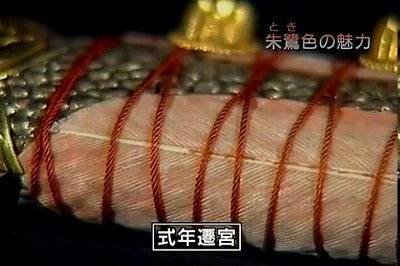
Despite the sword's sacred status, the ones you see in the above image is not actually the original sword.
You see the shrine has a tradition of being taken down and rebuilt every 20 years on an adjacent piece of land under the same exact specifications, based on the idea that new objects have greater divine power.
The Sugari no Ontachi is part of this tradition, ritualistically reforged every 20 years to retain its divine might. This would of course mean that the sword we have now is not the original, perhaps the original lies with Yago still?
Notably, the sword contains elements of its design that are anachronistic to when it should've first been forged, indicating that it must've received a redesign during one of these reforgings.
I do not know whether this should just be attributed to JynX not bothering to or not being able to copy the sword's design 1-to-1, but the sword in Yago's hand indeed features a slightly different design to the Sugari no Ontachi of our world, perhaps another point to Yago's being the original.
Counterpart Candidate #2: The Tamamaki no Ontachi
This is the other candidate for an outside world counterpart to Yago's Sugari no Ontachi, the Tamamaki no Ontachi (玉纏御太刀).
Below: The Tamamaki no Ontachi.
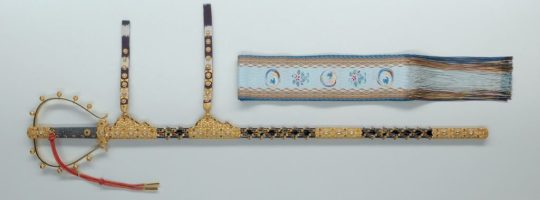
As you can see, the two swords are extremely similar in appearance, and are thus often considered a pair. In fact, the Tamamaki no Ontachi is also a sacred treasure of the Ise Grand Shrine's Inner Shrine and is similarly reforged every 20 years.
There's not much more tying the two swords together, but it doesn't take much investigation to see why this could be the counterpart to Yago's sword.
Yago as a God
Finally, I want to devote a small section to Yago's status as a god, as they're one of the few windows into what godhood is like in Mugenri (alongside Souko, of course).
Powers After Becoming a God
We know that Yago (and Souko too) didn't start off as gods, but instead as a "human-like" being (which I theorise to be the race that split into humans and non-humans in the future, like Hoojiro mentions).
Instead, they became gods after their contributions in certain fields got acknowledged, by a group of yet-unknown people, and they got promoted to godhood.
Alongside this, they gained incredible longevity, but is this the only power they gained as a god?
Curiously, Yago seems keenly aware of Suzumi messing with time during the evens of BPoHC, and is even able to hear the voice of Ardey, and deduce that there are two souls inside Suzumi.
It is curious that they are seemingly unable to detect the presence of Benny, perhaps it is simply because they didn't speak during that conversation, or perhaps there is something more here.
Whether this is something inherent to Yago or something that they learnt after becoming a god (personally I lean towards the later), it is still a very interesting tidbit.
Godly Spell Card Backgrounds
Now for a much more lighthearted one, Yago actually shares part of their spell card background with Souko, likely symbolising their equal status as gods.
Below: Yago's spell background (left) with Souko's overlaid on top (right).
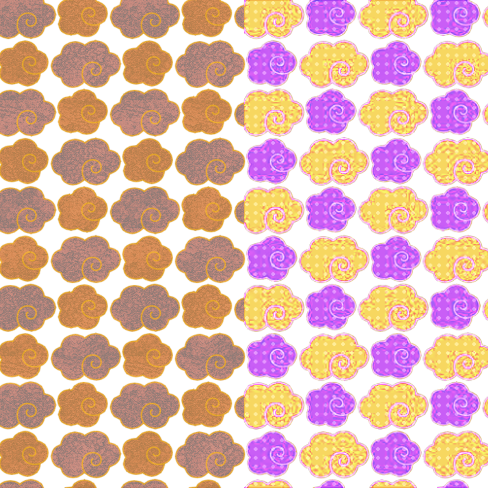
Clouds shaped like these have long been a popular motif for wood carvings decorating Japanese Shinto shrines and Buddhist temples, and so it's not surprise at all that Yago and Souko, gods themselves, would reference this pattern as well.
Below: A carving of a dragon surrounded by such clouds at the Suga Shrine (須賀神社), Yabu city, Hyōgo prefecture.
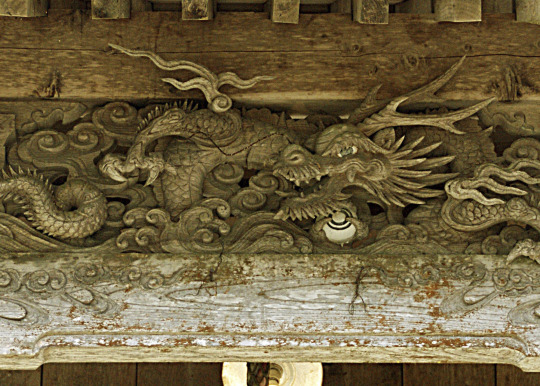
Ending
And that, I believe, concludes my revisit to Yago Ametsukana, my favourite Len'en character of them all.
I decided to really lean on the mythology side of things with this analysis, since it's what made me fall in love with Yago in the first place. Though I really enjoy them as a character too! Perhaps I'll write about that some other day~.
In any case, and as usual, I hope you enjoyed~! :)
#len'en#len'en project#len'en lore#yago ametsukana#honestly so glad to have done this#I feel like I really eclipse the original with this one#still gonna keep that one around though#it is my first analysis after all#and no reason to get rid of it when it's not wrong or anything
26 notes
·
View notes
Text
The Shirakawa Yoshimi Shrine
I already got my preamble over in my last post, so there's no need for one here, let's get right into it!
Right after the visiting the Kamishikimi Kumanoimasu Shrine, we went to the nearby Shirakawa Spring (白川水源 lit. "white river water source").
So here's the shrine within the grounds of which the spring is found, the Shirakawa Yoshimi Shrine (白川吉見神社), located on the souther foot of Mount Aso.
Below: The entrance of the shrine, as marked by the two komainu statues and the shimenawa bound torii gate. From this website on the shrines of Kyushu.
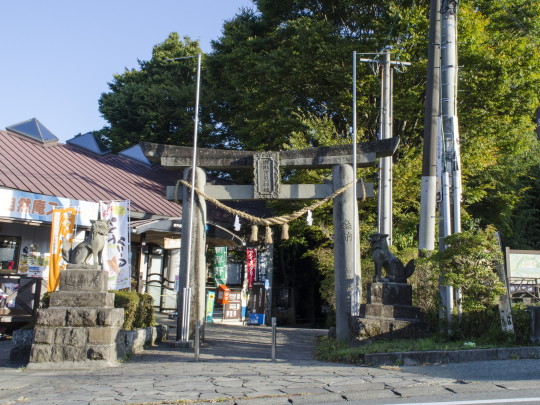
My visit to the shrine
Like I mentioned, we headed here right after leaving the Kamishikimi Kumanoimasu Shrine from my last post.
Unlike that shrine, this one's rather more famous (or rather, its spring is famous), and so has a car park located conveniently next to the shrine's entrance, as well as a gift shop selling local goods and souvenirs.
Below: My own image of the shrine's entrance.

As you could see, I only caught the un-shaped komainu statue, i.e. the one with its mouth closed, this was cause stand any further back and I'd be out on the car road. So instead:

Here's another one with the a-shaped komainu, i.e. the one with its mouth open. Together, they are said to form "Aum" (or perhaps more commonly "Om"), a sacred syllable in many religions, Buddhism included.
Anyways, we passed through the gate, we walked along the shrine road, which had a few souvenir shops and little rest houses as well, and even this little stall!

"Everything is 100 yen!!" It's an unmanned shop probably where local farmers leave their excess crops to sell, here we see bags of potatoes and eggplants.
Passing the shops and stands we move into an area where the trees part, coming face to face with a river. This is of course the eponymous Shirakawa (白川), "the white river".
Below: A section of Shirakawa I saw on the way to the spring.

Finally, we arrive at the shrine proper, passing by a toll gate. The shrine's been getting more and more visitors due to its fame, and so started collecting a modest fee of 100 yen per visitor (of high school age and above) for environmental conservation.
Before passing the second torii gate and going to the shrine building, we find a lowered platform that allows visitors to get near the river.
Below: The lowered area.
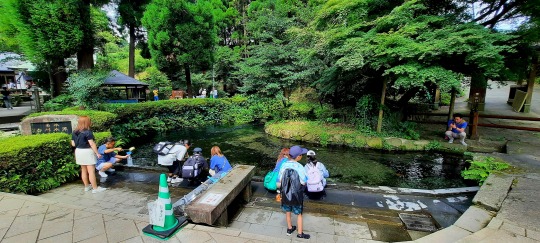
The tray on the left of the wooden bench has various funnels and ladles, allowing visitors to get their own bottle of pristine Shirakawa spring water. I myself took a sip of the water, and it was refreshing indeed~.
Notably, the river itself also serves as where visitors cleanse themselves before paying respects at the shrine. Shinto deities abhor defilement and impurities, thus it is customary to cleanse oneself, typically with water.
A good number of shrines have a fountain, called a chouzu-ya (手水舎 lit. "hand water pavilion"), where one is expected to wash their hands and mouth, to purify themself before meeting the shrine's god.
However, this shrine simply uses the natural spring water that flows from within shrine grounds. After all, why use the man-made when we have access to the gods' blessings directly?
(Do note though to be careful not to let water spill back into the river, and definitely do not spit water that's used to cleanse your mouth back into the river. The floor around will do.)
Below: The entrance of the shrine proper, pass the shrine road, from the same site previously mentioned.

Having cleansed myself, we go through the shrine's second torii gate and towards the shrine buildings. The engaku (on both gates actually) reads, plain and simple, "Shirakawa Yoshimi Shrine".
Below: The second torii of the shrine, pass it is the shrine proper.
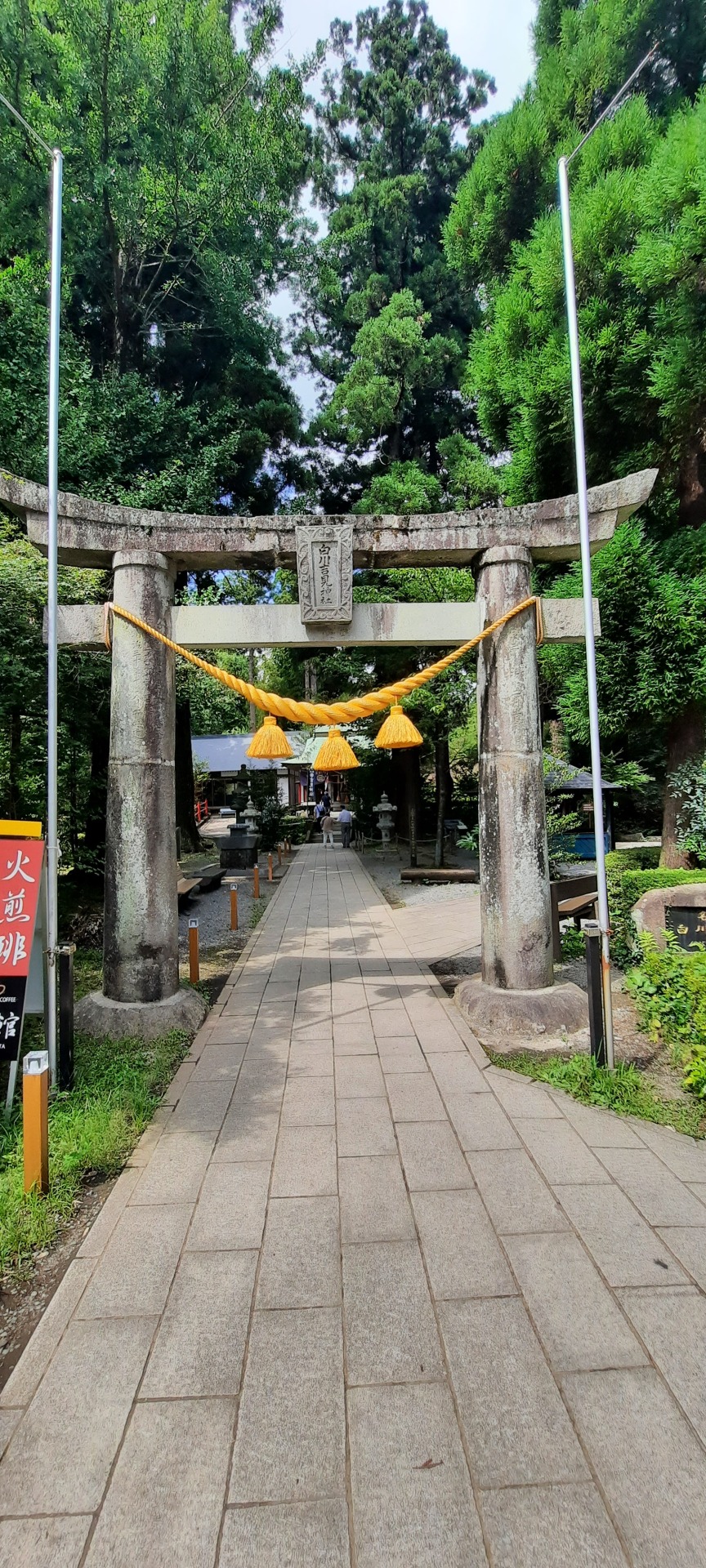
Right after we enter, on the left is a typical man-made chouzu-ya fountain, on which reads "seishin" (清心), "to purify one's heart" or simply "pure heart, which is how one should conduct themself before the gods.
Below: The shrine's proper chouzubachi, taken from the same site once again.

Of course, as you see from the image, it doesn't even have a ladle for you to get water from it. They really do expect visitors to cleanse themselves with the river, after all.
As you can see from the image of the torii gate, the road branches into two. We went on the right path first, which leads to the shrine's greatest treasure: The Shirakawa Spring.
However, before reaching the spring, we come across a small hokora (祠), a small-scale shrine where local folk deities are often enshrined. This particular one enshrines Suijin (水神 lit. "water god") the god of the spring.
Below: The roadside hokora.
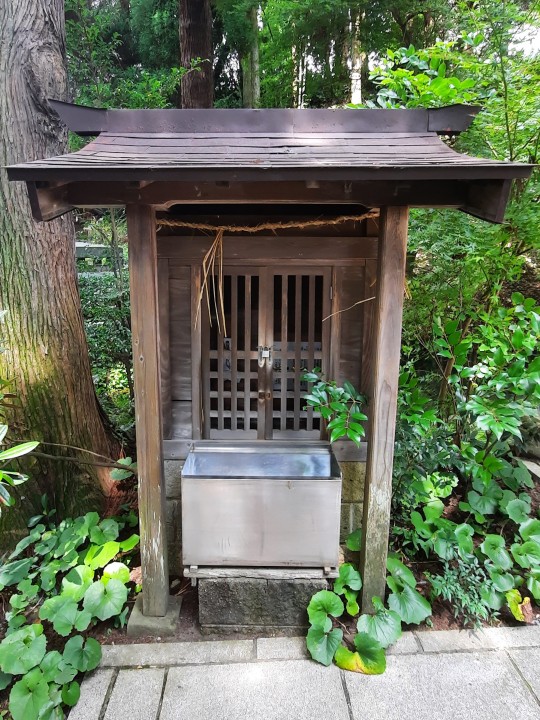
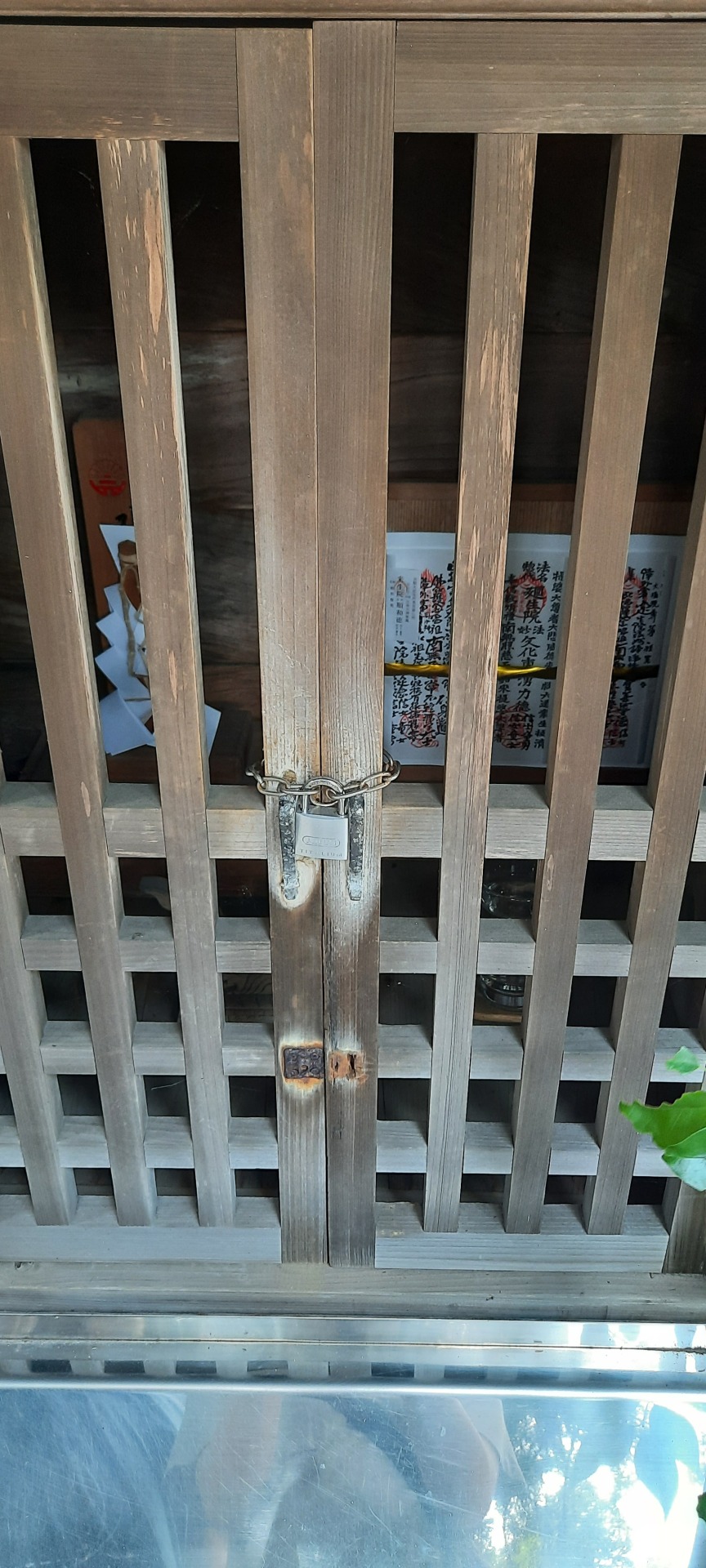
Anyways, passing the hokora by we reach the spring itself!
Below: The Shirakawa Spring.

The spot in the middle that's especially blue is where the water was gushing out from, and oh how clear the water was! And look at the moss growing on the river bed! It really was an awe-inspiring sight~.
Here's a video, which hopefully shows off how water gushes out from the riverbed (don't mind the cicadas lol it was prime cicada season).
After marvelling at the spring, I took a quick look the shrine buildings. Starting with: The prayer hall. The flags being displayed out front read "Yoshimi Shrine" (吉見神社).
Below: The prayer hall.
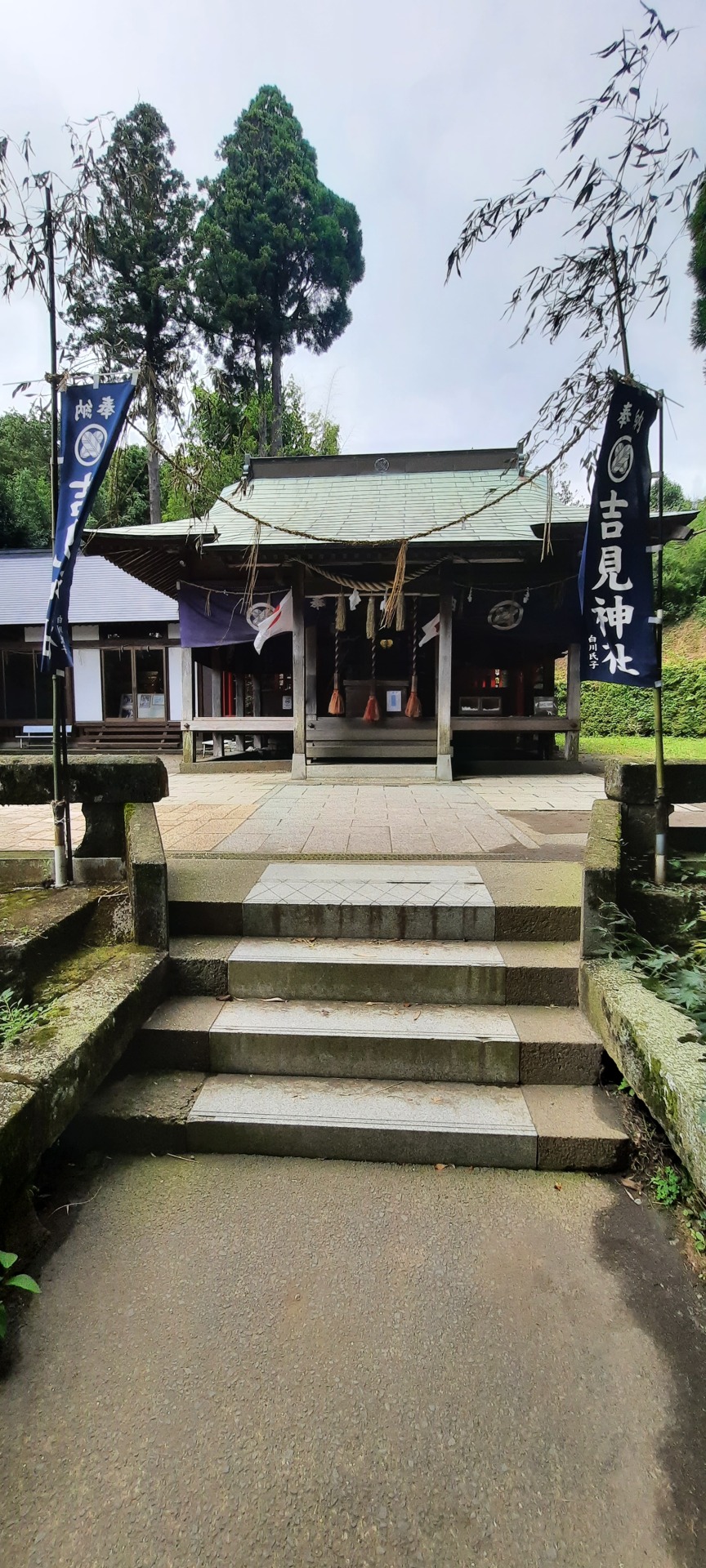
The white building to the left of the shrine is the shrine's mikoshi storehouse, mikoshi (神輿) being divine palanquins in which the gods' spirits are housed during festival parades.
Below: A glimpse of the palanquins as seen from outside.

Next, I went to the right of the prayer hall, and took the following side-shot of the shrine building. Here we can get a glimpse of its main hall too, where the gods are housed.
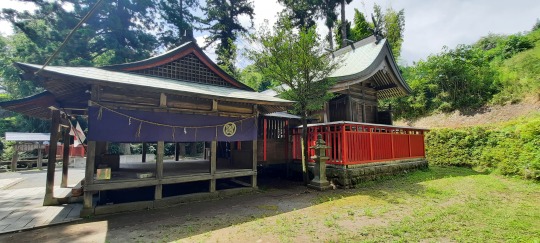
Opposite the main hall, on the right, is a smaller subsidiary shrine also under the management of the Shirakawa Yoshimi Shrine.
This one is simply classified as a keidai-sha (境内社 lit. "shrine within [shrine] grounds"). It used to be that these subsidiary shrines are divided into two types:
Sessha (摂社), colloquially called "auxiliary shrines", where gods related to the main shrine's gods are enshrined; and
Massha (末社), "undershrines", where unrelated gods are enshrined.
It used to be that auxiliary shrines are at a higher rank than undershrines, but this class system has now been discarded, any some shrines no longer list out which these subsidiary shrines used to be. This is one of them.
This particular shrine is a combination of three, first among which is a Tenman-guu Shrine (天満宮 lit. "Palace of Tenman"), which enshrines the famous scholar god Sugawara no Michizane, or Tenman Tenjin (天満天神).
Below: The subsidiary Tanman-guu Shrine.

Alongside the great Tenjin, two deities long since worshipped by local villagers are now also enshrined here, they are two particular aspects of the bodhisattva Kanzeon (観世音): Safe-childbirth Kanzeon (子安観世音) and Horse-headed Kanzeon (馬頭観世音).
Below: The statues of Tenjin, Safe-childbirth Kanzeon and Horse-headed Kanzeon (in order), enshrined within the Tenman-guu Shrine. From this shrine-themed website.



Safe-childbirth Kanzeon is said to impart, as the name suggests, safe childbirth; While the Horse-headed Kanzeon (who funnily enough doesn't have a horse head here) is said to protect travellers.
Combined with the scholar god Tenjin, this is a surprisingly potent shrine, covering a good chunk of our early lives.
One might note that Kanzeon, perhaps more commonly known in her Chinese rendition as Guanyin, is not exactly a Shinto deity, but rather a Buddhist figure.
This should come as no surprise if we look at Shinto and Buddhism's history in Japan, where they were, for most of its history since the introduction of Buddhism, viewed as the same thing.
And thus it's actually not uncommon at all for Buddhist features to be found in Shinto shrines, nor vice versa. That's all I'll say here, so as not to derail things, though if any of y'all are interested I could certainly write on that as well.
In any case, that's the entirely of the shrine explored, and we head off to our next destination.
History
Now that our tour is over, we can move onto the history of the shrine.
This shrine, being a comparatively larger scale shrine, has a clearer history than the last one, well-kept by the shrine's records. So, here's the Shirakawa Yoshimi Shrine's history, as told by the shrine itself.
Below: The sign on which the shrine's history can be found.
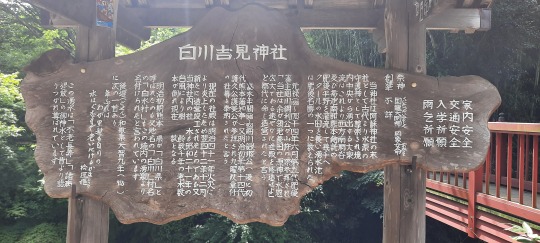
Official Shrine History
Year of Establishment: Unclear
Since ancient times, this shrine's has been considered the protector shrine of the Shirakawa Spring as the undershrine of the Aso Shrine (阿蘇神社).
The great spring gushing out from the center of the shrine is considered one of the greatest views of Higo (肥後 the historical province the Aso region is found in).
Its water flows through the Nangou Valley (南郷谷) to the west, then through southern Kikuchi (菊池) to finally supply water to the several thousand hectares of water paddies in the Higo plains (肥後平野) in Houtaku, Kumano.
In the 6th month of Genroku 14 (1693), the 5th lord (藩主 hanshuu) of Higo, Lord Tsunatoshi Hosokawa (細川綱利), visited this shrine when out hunting on the mountains.
He declared to the district administrator (郡代 gundai), "This shrine is where the spring god who supplies the fields in my land resides, and my gratitude for their grace is great indeed. With haste, build a shrine building here." Thus was the origin of this shrine.
It is said that the shrine curtains featuring the Kuyou (九曜 lit. "nine stars") emblem were offered up by Lord Yoshikuni Hosokawa (細川韶邦) (future first han-chiji of Kumano) during one of his visits, during the Kaei era (1848—1853).
Alternatively, it is said that it was offered up by the 14 generation's Lord Morihisa (護久) and Lord Moriyoshi (護美) during one of their visits, during the first year of the Meiji era (1868).
The current shrine building was built and completed in December of Meiji 42, as the previous building had burnt down in a fire a year prior, in Meiji 41 (1908).
Also, several old trees of several thousand-years old fell during a typhoon in Shōwa 21 (1946), reducing the number of shrine trees to what you see now.
It's said that the shrine's spring is why the Kumano prefecture was called the "Shirakawa Prefecture" during the early Meiji era, why the local region is called "Shirakawa" and also gave its name to Shirakawa Village.
The Later Collection of Japanese Poems (後撰和歌集), compiled in Tenryaku 5 (951), contains the following poem:
Many years have passed, my black hair too, seems to have gotten old. Just as how I now draw water from the Shirakawa. — Higaki no Ouna (檜垣嫗)
The spring water has long been spoken of respectfully as divine water that grants "longevity without ageing" and "dispersal of current illnesses".
Overall History
And that's everything that's written on that sign! There's a bit more to go though, expanding on what the shrine's own records along with other records tell us.
To start with, we're actually going back to that poem by Higaki no Ouna. If it is true that the name Shirakawa came from the shrine, this would mean that it needs to be at least as old as the Later Collection of Japanese Poems, in which the poem is found.
Higaki no Ouna's Poem A bit of context for the poem, Higaki no Ouna is poet said to have been a prostitute known for her refinement. This poem is said to have been composed by her as she was fetching water from the Shirakawa river, lamenting how she had fallen into ruin with old age, having to fetch water herself rather than being able to have someone else do it for her. Here both "Shirakawa" and the phrase "draw water" are kakekotoba (掛詞), or "pivot words", a technique used in Japanese waka poetry where kanji carry two layers of meaning, one literally from the kanji and one from its reading. Yes it's basically a pun, in a sense. But it's elegance comes in how it allows the poet to use less syllables in the poems, while at the same time expressing more. This brevity is considered key in these poems. The two here respectively point to "white hair" and "teeth that emerge as one becomes old", both pointing to how old Higaki no Ouna now is.
The collection was compiled in 951. means that the shrine has to have existed in some capacity by the late Heian period (794—1185).
However, according to the Aso Shrine's records, the undershrine mentioned in the shrine's records was not establiished until the end of the Tenshou era (天正), around 1573 to 1593.
Thus it is thought that this place had been home to a water god faith even prior to its establishment as an undershrine of the Aso Shrine.
Whatever the case, during its time as an undershrine, its resident water god was Himemiko-no-Kami (比咩御子神), the goddess of the 3rd palace of the Aso Shrine.
The next notable part of the shrine's history is with Tsunatoshi Hosokawa, you might notice that the above sign makes it sound like he ordered for a shrine to be built where a shrine already existed.
It's not exactly clear what the passage means by this, though it could mean that it didn't have a proper shrine building before this.
Skipping ahead, it is in the 1st year of Meiji that the shrine gets to its current form. It was re-assigned as a Yoshimi Shrine (吉見社) during this period, replacing its old head shrine of the Aso Shrine with the Kusakabe Yoshimi Shrine (草部吉見神社).
Alongside this change, the Shirakawa Yoshimi Shrine adopted the Kusakabe Yoshimi Shrine's head god, Kunitatsu-daimyoujin (国龍大明神), and changed its water god to be Mitsuhanome-no-Mikoto (罔象女命).
Mythology
The mythology of this shrine isn't going to be as interesting as the last one, since there's no particular tale behind the shrine or the spring's origins.
So instead, let's briefly go over the shrine's main blessings, as well as the various gods it's once enshrined.
Blessings
According to the sign above, the shrine has 2 main blessings: Safety at home and Safety in traffic;
Additionally, it's also known to be particularly responsive to two types of prayers: That for school admissions and rain.
Gods
As mentioned in the history section, the Shirakawa Yoshimi Shrine likely had three generations of gods, starting with an theorised water god before formal shrine worship, though there's nothing much to really say about this one, so we can move on to generation 2.
Next the shrine was formally established as an undershrine of the Aso Shrine. The Aso Shrine's head god is Takeiwatatsu-no-Mikoto (健磐龍命), grandson of legendary 1st Emperor Jimmu.
You might recognise this to be the very same Aso-daimyoujin (阿蘇大明神) mentioned last time. We are in the Aso region after all, it only makes sense that the "great shining god of Aso" take central stage.
The Aso Shrine is mainly divided into twelve "palaces", and Himemiko-no-Kami is the goddess of the fourth palace.
She is Takeiwatatsu's aunt, through marriage to his uncle, and was taken to be the the Shirakawa Yoshimi Shrine's water goddess while it was under the Aso Shrine's jurisdiction.
The shrine was later reclassified to be under the Kusakabe Yoshimi Shrine's lineage, which is actually not too surprising when you consider that this shrine's head god is Kunitatsu-no-Kami (国龍神 lit. "country dragon god"), Himemiko's husband.
Kunitatsu is perhaps more readily known outside of Aso as Hikoyai-no-Mikoto (日子八井命), Emperor Jimmu's eldest son.
At the Shirakawa Yoshimi Shrine, he is eulogistically titled the "Great shining god Kunitatsu" (国龍大明神 Kunitatsu-daimyoujin) and seems to have replaced his wife's role as water god of the spring.
This would likely be because he is worshipped as a water god at the Kusakabe Yoshimi Shrine, making him a better fit for this role than his wife, who doesn't seem to have any connection to water (though admittedly I couldn't find much on her to begin with).
Finally, it is also at this stage that Mitsuhanome-no-Mikoto (罔象女命) was added to the shrine's pantheon. She is famously the water goddess born out of a dying Izanami's urine, but not much else is known about her beyond this.
Still, a water goddess is a water goddess, so she fits right in at the Shirakawa Yoshimi Shrine.
Ending
And that concludes my dive into the Shirakawa Yoshimi Shrine, this one's quite a bit more dry this time, perhaps due to the shrine having less of a colourful story, but it's still a wonderful place, so I hope you enjoyed all the same~!
#japan#japanese mythology#shinto shrine#shirakawa yoshimi shrine#you would not believe#how much time and research it took me#to understand that poem#I'm not remotely familiar with classical japanese after all lol#100% worth it though imo#my curiosity must be satisfied
7 notes
·
View notes
Text
The Kamishikimi Kumanoimasu Shrine
Today's post won't be on Len'en, like at all, so uhh, nothing for you if you only care about that I suppose~.
Anyways, I went on a family trip to northern Kyushu around a month ago, so I thought to share some of the neat places I've been to! (Not in any particular order though, just whatever I feel like.)
It'll probably just be the shrines and temples and such, since that's what I'm most interested in, but I'd be more than glad to share the rest of my trip if you all would like to see~!
With that preamble out of the way, here's my visit to the Kamishikimi Kumanoimasu Shrine.
Below: An image of the shrine road going up the mountain, from the official Takamori Town website.
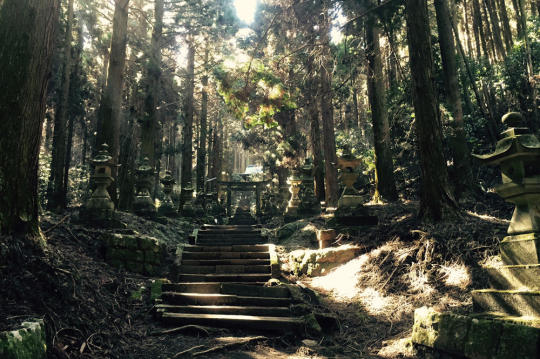
My Visit to the Shrine
Unlike most places on our trip, this is actually a place I've been before, on my last trip around winter 4 years ago. It was just such a wonderful place that we had to bring my little brothers to as well.
(Though they didn't appreciate it much, on account of how incredibly hot it was. Honestly I don't even blame them, it was around 38°C every single day during the trip, so outdoor activity was, tough, to say the least.)
The Kamishikimi Kumanoimasu Shrine (上色見熊野座神社) is Located in Takamori Town, Aso District, Kumamoto Prefecture, on the foot of Mount Tsukigata (月形山), in a place known as Kami-shikimi (上色見 lit. "upper Shikimi", in contrast with Shikimi, located to the east.)
It's accessed directly from the side of a car road, opposite a post office, so we parked our rental car nearby and started heading up the shrine road: A rather long set of stairs up the mountain.
(As another aside, the pictures here were taken by me during the visit, unless otherwise noted, so you'll have to pardon the quality.)
Below: The entrance of the shrine, marked by a sign with the shrine's name beside it. (I had to take this one from the post office parking lot, on account of the traffic lol.)

The road was very tranquil, barring the occasional tourist/visitor, lined with many stone lanterns and trees with the occasional stone torii gate as well.
Below: A few photos that I took along the stairs.

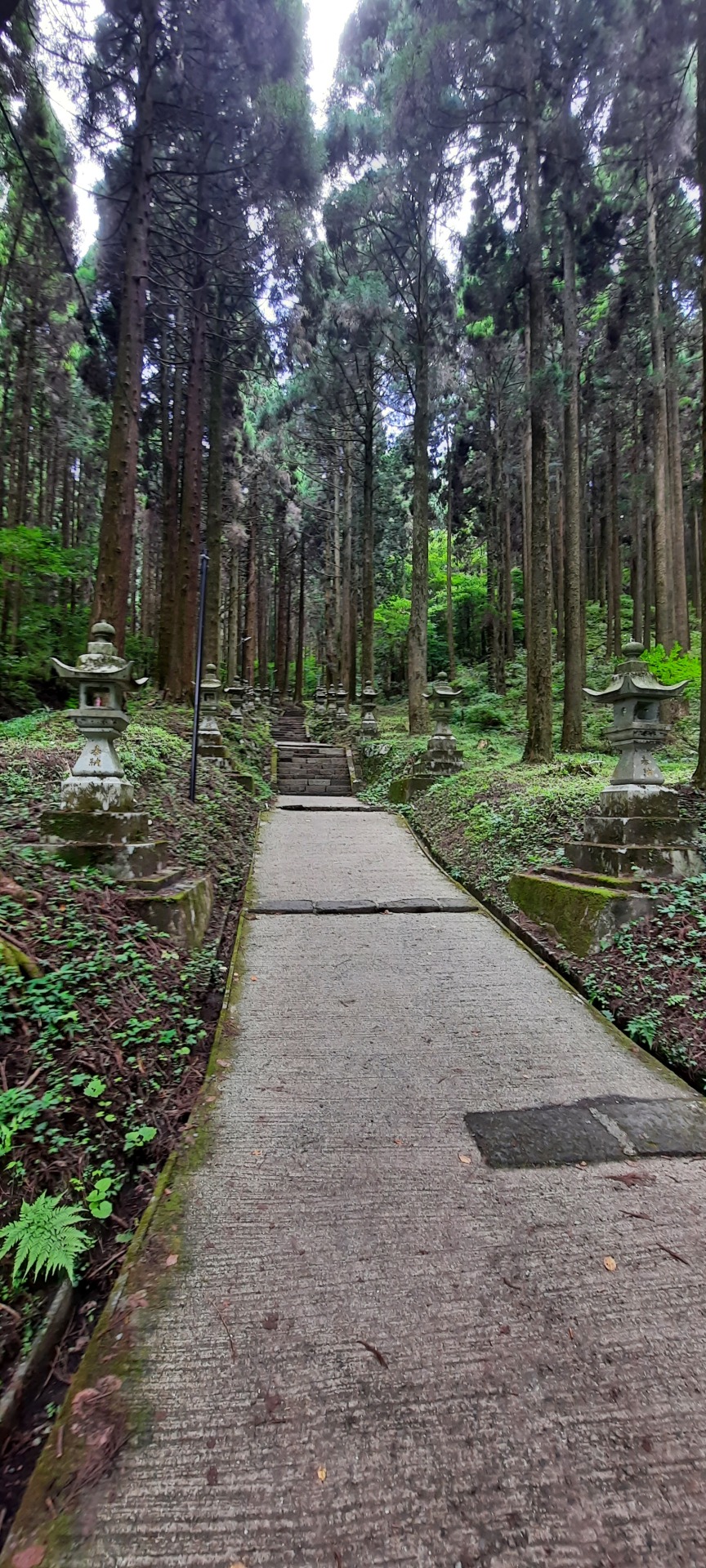


Upon the gates hang a shimenawa rope, noting the sacred space we're entering, alongside the torii itself of course.
Written on the torii's shingaku (神額 lit. "god/divine frame"), the picture-frame like object on the middle of the gate, are the words Kumano-guu (熊野宮 lit. "palace/shrine of Kumano"), an older, alternate name of the shrine.

Along the hike, we came across this stone, clearly divine in nature somehow, considering the money offerings, its being bound by shimenawa and having an oonusa, a type of ritual wand, next to it.
It's quite peculiar, but we'll circle back to it later.
Below: The curious stone.
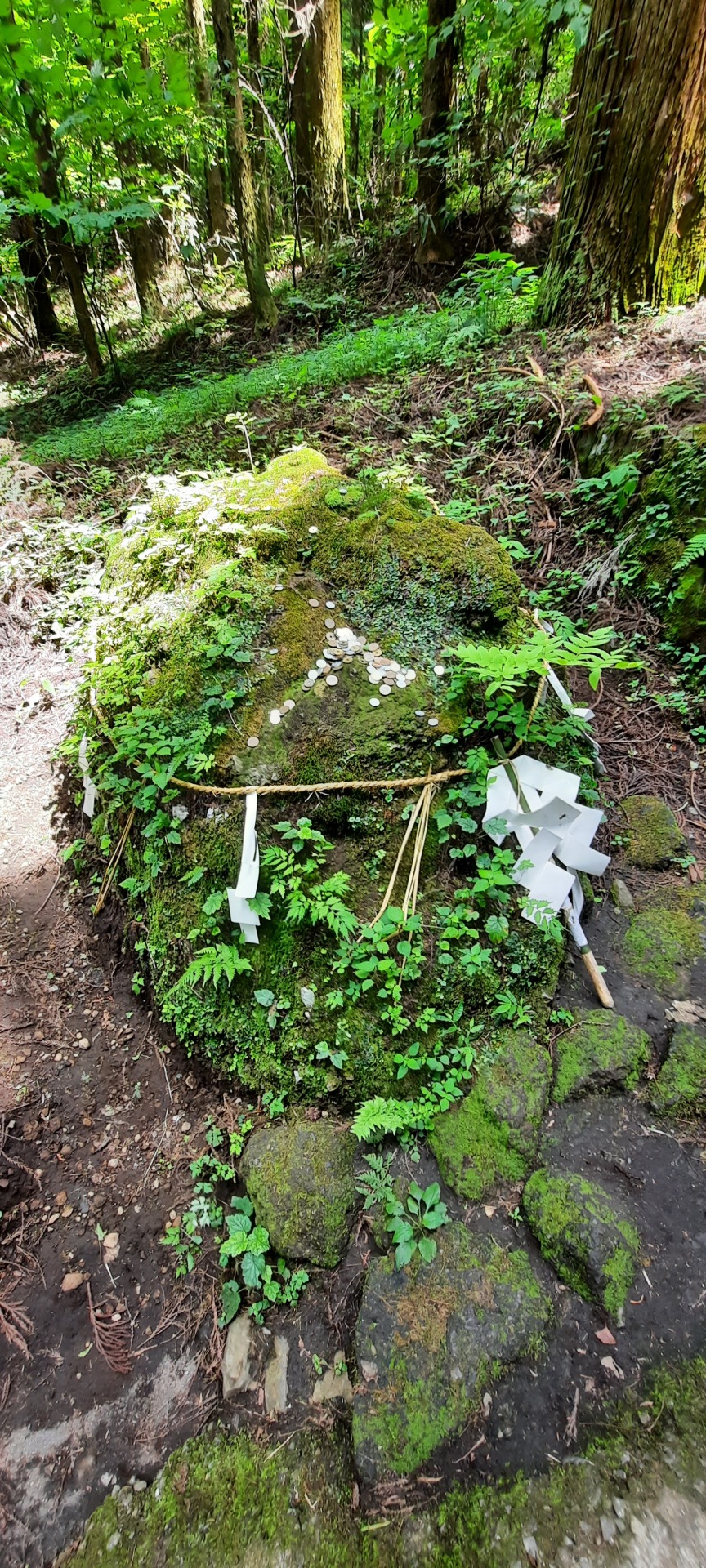
At the end of the stairs, we come face to face with the shrine itself, specifically its prayer hall.
Below: The prayer hall. (It's a bit blurry cause I think I was a bit shaky after climbing all those stairs lol.)

This is where visitors would give their offerings and prayers to the gods, as well as where priests and shrine maidens would've carried out their rituals and performances. (There weren't any during our visit though, this isn't a shrine that's manned every day.)
Below: A view of the entire shrine, from this shrine/temple-focused travel website.
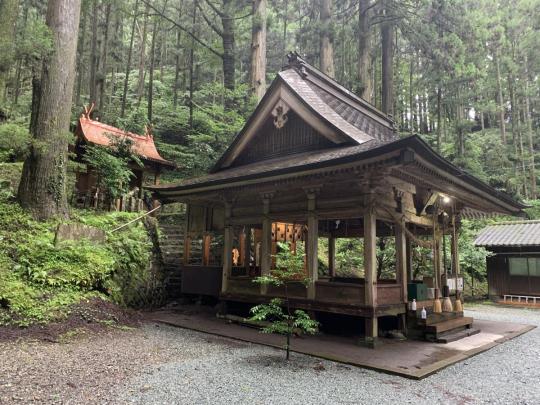
As you can see from the picture here, behind the prayer hall are a set of stairs leading to a smaller building, this is the shrine's main hall, where its shintai, a sacred vessel for the gods' spirits, is housed.
Below: A side view of the main hall.

One would normally assume that this is where the shrine ends, but there's actually a site further up the mountain that's also related to the shrine!
It does demand that we take yet another hike up, but thankfully it's not nearly as long this time (though much more overgrown with grass, as this path is not paved like the shrine road is).
As we hike up, we see our goal, a giant blowing cave known as Ugeto-iwa (穿戸岩).
Below: The path up to Ugeto-iwa as well as the hole itself.
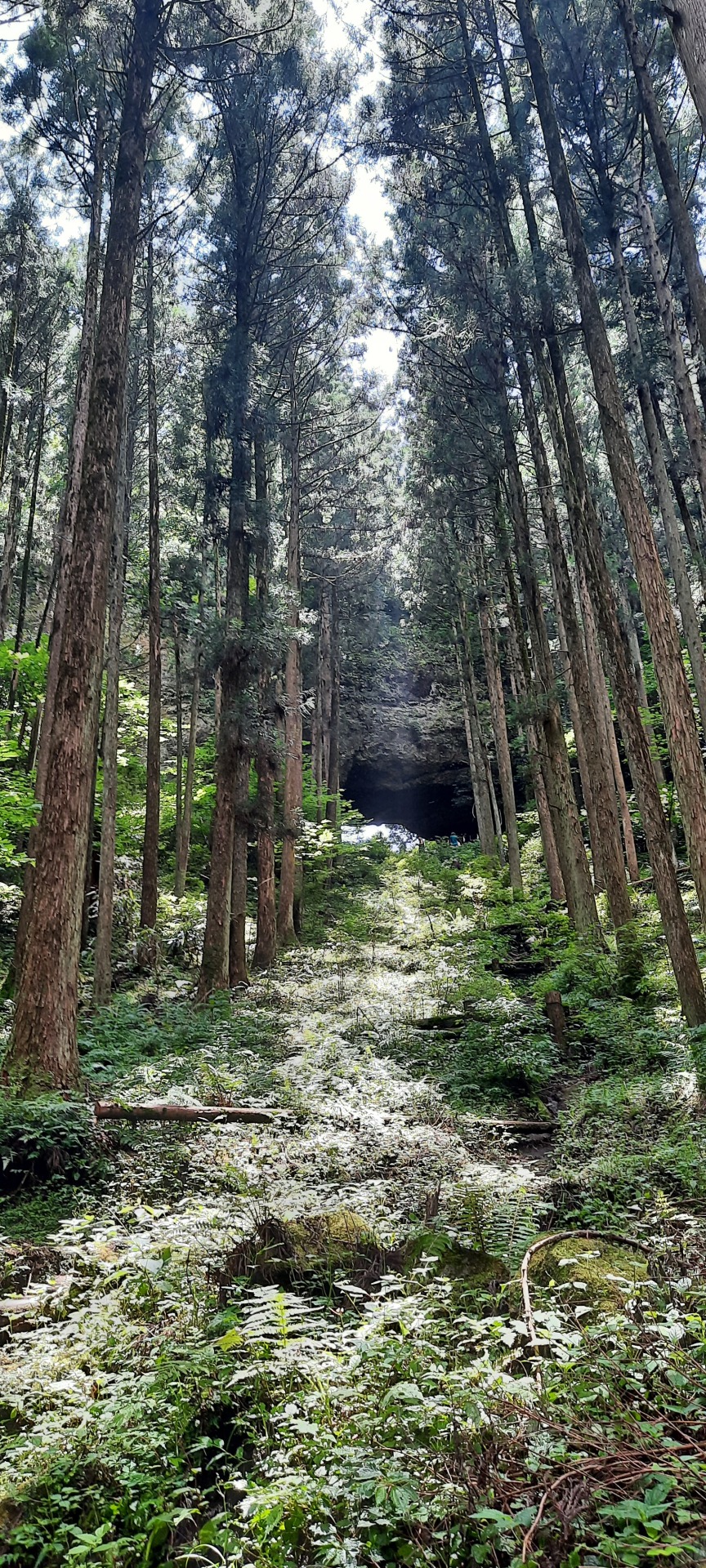


Along the path to the cave as well as around and inside it, are many stone stacks, built by visitors to the shrine and the cave.
While these are most commonly known for helping children stuck at Sai no Kawara (賽の河原) finish their punishment and move on to their next life, they actually have a number of other ritual meanings as well, like symbolically leaving ones impurities behind with them.
Below: The stone stacks.

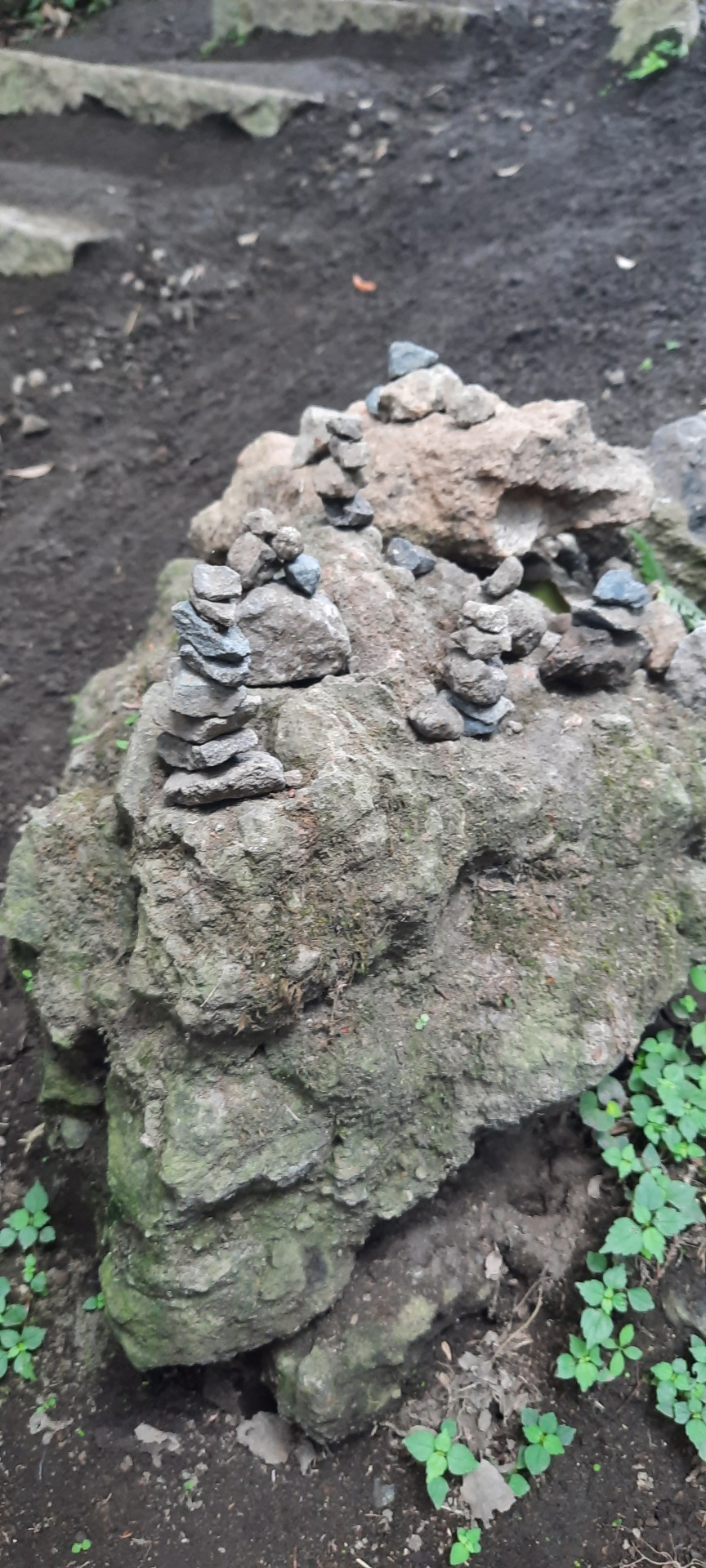

There's no way for me to find out why visitors to this shrine first started stacking stones, but I made my own contribution as well. The top stone you see in the following picture was mine!

I didn't enter the cave myself, since I thought that we weren't allowed to after seeing the shimenawa up top. Though my dad later told me that he saw the locals going in to pray, which led to further research on my part.
This is where I learnt that, the cave itself is sometimes considered a separate shrine of its own, where the mountain in which the cave is found is its shintai. This shrine is known as Ugeto Shrine (穿戸社 lit. "excavated door shrine").
On the left within the cave is its own offering box (which you can kinda see in my picture as well), and in this picture below we can even see sake offered to the god, along with an oonusa again.
Below: The offering box in the cave, from the same travel website previously mentioned.

Thus, with the pinnacle of the shrine reached, we turn around and head back down, moving onto our next destination.
History
Right, with that initial introduction out of the way, we can now get into the history and mythology of the shrine.
First of, its historical origins! Right off the bat, the history of this shrine is not well understood, as its just that old of a shrine.
History as a Ko-shinto Ritual Site
Shinto worship did not always involve these buildings we call shrines, especially in the period prior to the introduction of Buddhism to Japan. This period of the religion is sometimes known as Ko-shintō (古神道 lit. "ancient shinto").
During this period, they had much more simple ritual sites that were often not permanently marked. Thus it's often hard to pin down when a shrine's history truly began, and this is one such case.
It's believed that this site has long been of ritual importance, archaeologists have discovered multiple kofun burial mounds dating back to the 4th to 5th century around the broader Kamishikimi region, in which this modern shrine is found.
And it's believed that the locals at the time often took boulders and blowing caves, a rare type of cave, as objects of worship. Thus it is not a stretch at all to theorise that this cave was one of their sites of worship either.
History as a Shinto Shrine
We have a slightly better idea as to when an actual Shinto shrine was built here, with scholars proposing around the late Kamakura period (1185–1333) or early Muromachi period (1336—1573).
The shrine's records claim that it has its origins in Kishū Kumano (紀州熊野), the southern region of the historical Muro District of the Kii Province, which was also called "Kumano".
Presuming that this is true, this shrine likely has its origins with the famous Three Grand Shrines of Kumano (熊野三山), which would make perfect sense, considering that one of the shrine's names clearly mention Kumano.
As for how shrine of the Kumano faith, originating in the modern day Mie and Wakayama Prefectures, came all the way across the sea to Kyushu, it is believed to tie in with the rise of Shugendō.
During the period, Shugendō practitioners started spreading their faith and shrines across Japan, taking the Kumano faith with them. As they held mountains as objects of worship, it's likely that they decided to set up a shrine on this mountain as well, taking note of its curious cave.
Concrete History
Finally, we have two pieces of (almost certainly) concrete history: First is that the shrine is made to be the overall protector shrine of the local area known as Nangou (南郷 lit. "southern country"), the southern parts of the Aso area.
A second bit that absolutely is true, is that the shrine I visited was not the original building, as it burnt down from the flames of war during the Tenshō era (1573—1592) and was abandoned, only returned to and rebuilt during the Kyōhō 7 (1722).
Mythology
That sorts out history, so lets look at the mythological origins of the shrine, as reported by the shrine itself.
The 2 Gods of the Shrine
The shrine enshrines 2 gods, the famous Izanagi-no-Mikoto (伊邪那岐命) and Izanami-no-Mikoto (伊邪那美命). They are the creator gods that literally gave birth to the many islands of Japan, as well as the many of the gods that inhabit it.
Additionally, the shrine also notes a more local name for the two gods, where they are combined as one under the name "Ugeto-gongen" (穿戸権現 lit. "avatar of the excavated door").
These two are likely the gods of this shrine because they are the chief gods of the Three Grand Shrines of Kumano.
Legend of the Cave, Ugeto-iwa
The shrine also passes down a seemingly legend, seemingly older than the shrine itself, that talks of how the shrine came to be.
Long ago, the god known as Aso-daimyoujin (阿蘇大明神 lit. "Great shining god of Aso"), credited in other legends as the creator and god of the volcanic Mount Aso (阿蘇山), really enjoyed archery.
He would shoot his arrow from the top of Mount Aso and have his retainer, Kihachi-boshi (鬼八法師), retrieve the arrows for him.
One time, finding his task extremely annoying, he picked up one of the arrows in the gap between his toes and threw it at his master out of frustration.
Enraged by Kihashi's actions, Aso-daimyoujin took off in a mad chase after him. Kihashi wanted to escape by climbing over the Somma volcano, but his way was blocked by Mount Tsukigata, the very mountain the shrine is found on.
This is when Kihashi kicked open a hole in the mountain, going through it and continuing his escape from his enraged master. This is how Ugeto-iwa came to be.
Ah, and remember that curious boulder that I came across on the way up to the shrine? That's what remains of the chunk of rock Kihashi kicked out!
The cave and the legend is said to represent "being able to achieve one's goals, no matter the difficulty". This thus lends itself to people saying that it grants blessing of success, victory and passing exams.
As a side note, taking other shrine records and legends into account, Kihashi is involved in many more antics.
He would fart 8 times during his escape, giving a location its name; kick open yet another mountain in his escape, and finally even become a vengeful spirit that causes frost to constantly fall once he was finally caught and executed, amongst many other tales. A surprisingly busy character.
Mythological Origins of the Shrine
While we already went into what the realistic historical origins of the shrine would be, the shrine also gives its own, mythologised account of its origin.
The shrine's records relay a separate a legend where Aso-daimyoujin's ara-mitama, the wild and raging aspect of their soul, is known as Iwagimi-shougun (石君将軍 lit. "General Iwagimi").
Iwagami apparently had a kabuto helmet known as the Hachou no Kabuto (八葉の兜 lit. "eight leaves helmet"), from within which emerged two gods, known collectively as Kumano-daimyoujin (熊野大明神 lit. "Great shining god of Kumano").
Of course, as already mentioned in the history section, the Kumano faith is what would bring Izanagi and Izanami to this shrine in the first place, so it only makes sense that these two are tied back to a locally important god like Aso-daimyoujin.
It is said that when people were about to build a shrine in honor of Kumano-daimyoujin. Two great birds came and took the sasaki branches meant as an offering to the god in their mouths.
The people gave chase, and followed the birds until they reached the eastern foot of this mountain, where they stopped where the cave is. And thus, they took this as a sign and built their shrine here instead, naming it the Kumano Ugeto Shrine (熊野穿戸神社).
Third god of the shrine
A much more minor note, while all sources online list only Izanagi and Izanami as the shrine's gods, a poster I found there adds a third god, Iwagimi-daishougun (石君大将軍 lit. "Greal general Iwagimi").
This is of course not too surprising, as Iwagimi is basically what brought forth Kumano-daimyoujin in the first place. (Which curiously kind of makes him the parent god of the parent gods, funnily enough.)
Ending
And that, concludes my little dive into the Kamishikimi Kumanoimasu Shrine!
If there's one final note to make, is that I totally recommend looking up pictures of the shrine. Its shrine road is especially famous, with many amazing pictures that really give an ethereal vibe.
Oh also, I don't know if any of y'all are into early 2000s shoujo manga (which is extremely specific now that I type it out lol), but Into the Forest of Fireflies' Light, by the same author as the famous Natsume's Book of Friends, was actually set at this shrine! So that's a fun fact~.

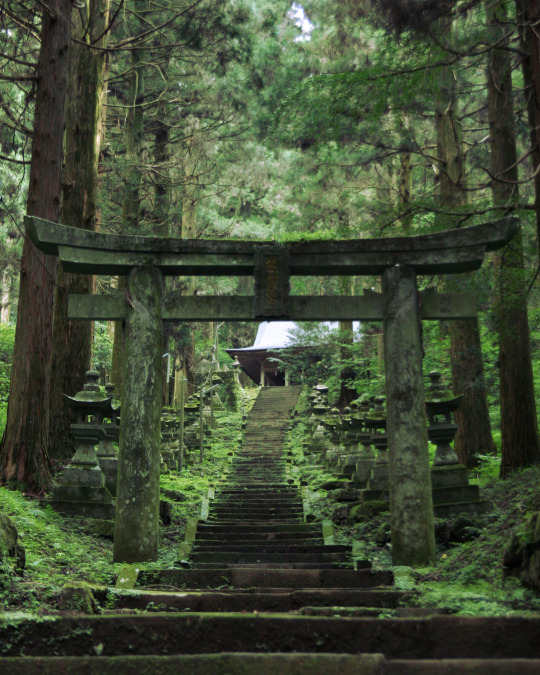
Anywho, that's really all I have now, for real this time. As usual, I hope you enjoyed, even if it's not quite what I usually do~! :)
9 notes
·
View notes
Note
What are your casual thoughts on Iyozane's themes?
Ah, Iyozane's themes, of course~!
I will note that I'm really just saying whatever I feel as I re-listen to these themes, so it may be more in-the-moment that my usual comments. Still, I hope you enjoy~!
In the Gloomy Straits, Steady as She Goes
幽暗海峡ヨーソロー
youtube
Iyozane's debut theme from RMI, I really like how the song does actually make me feel like I'm on a boat rocking along the waves, but still going steadily on.
It's the opening background melody that continues to repeat throughout the song that gives it that swaying wave feeling, while main melody accompanied by the steady drumbeats give it its, well, steady vibe!
Also a point that I really like is how right around the song's climax (~2:00) the Youkai Alliance's motif pops up, it really makes me feel like Iyozane's ambition is at an all time high during this incident (which makes a nice contrast with their theme in BPoHC).
Finally, the song looping and going back to its opening really hammers in that "steady as she goes" vibe. "Yoosoroo!"
Waves and Wind That Sway the Spirits ~ not steady body
幽霊うごく波と風 ~ not steady body
youtube
Iyozane's BPoHC theme, much like how the game sheds light on their shaky and ghastly (hehe) past, I feel like this rearrangement of their RMI theme also highlights this ghostly element of their character.
This ghostly unsteadiness is especially prominent in the opening of the song, with the little "twang" at the beginning of each repeating phrase.
It's also prominent in the section right before the climax (~1:40), with how it slowly builds up towards it but each layer just makes it sound even more unstable.
Also notable to me is how much "lighter" the main melody feels in this one, perhaps one might even say "weaker", not in the sense that it's worse but just that there's less strength behind it.
Maybe it's cause Iyozane's kinda bummed out after their failure in RMI, or maybe it's to again to highlight their potentially ghostly and ethereal nature. Either way, I find it of note~.
It's always fun to look out for the Youkai Alliance motif in the songs that have them, they tell a lot, imo. This time, it's nowhere as prominent, and instead is faintly hidden in the background (~2:18), starting out slightly stronger than how it ends.
Perhaps it only makes sense, considering their rocky relationship with the alliance during the Heaven-Shadow War, but I can't help but wonder if it also points to their ambition wavering a bit.

Also, who doesn't like a good pun in the title hehe.
Ending
Welp, those are my thoughts. Nothing amazing but I hope you enjoyed all the same~! :)
#len'en project#len'en#fujiwara no iyozane#oh yes that “yoosoroo” bit is what we have translated into “steady as she goes”#I kinda apologise for just randomly injecting it into it but#I always imagine iyozane quietly telling themself “yoosoroo”#in a dragged on sorta way as they navigate their boat through the strait#my only regret is that I can't directly beam this image into your mind lol
14 notes
·
View notes
Note
Do we know more on Médias?
Hmm, our own cute little penguin friend! I'll note right now that there's not much that we know, so you might not learn anything new in this. Still, let's take a look at what we do have!

Southern Meteor Shower — Medias Moritake
Medias and Their Home
Medias belongs to a tribe of emperor penguins from a country far to the south of the Sanctuary and Devenagara, known unofficially as the "Southern Country of Penguins".
Not too much is known about this place, other than that it's extremely cold and home to many an emperor penguin.
Medias is a dispatch soldier from this land, sent to Devanagara upon Mitori's request, as an attempt by both countries to establish diplomatic relationships with one another.
On a personal level, Medias is doing this to raise money to provide for their friends’ chicks. Perhaps because of this goal, or maybe that's just how they are to begin with, they're apparently a "big sucker for money", and would do anything to get their hands on more.
Name: Medias Moritake
Perhaps customary to Medias' tribe, they originally had only one name: Medias.
This refers to a type knitted fabric made from a technique similar to the stockinette stitch, which came from Spain and Portugal.
Below: A diagram illustrating the stitch pattern in Japanese medias.
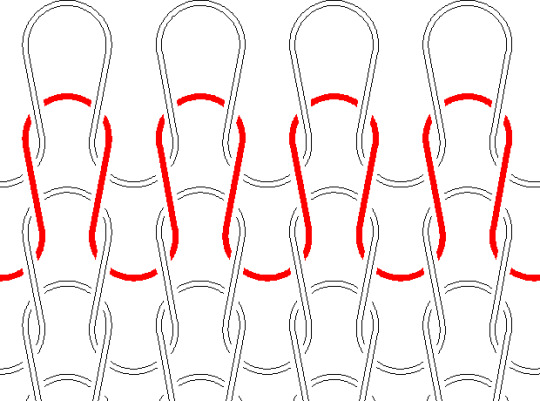
Medias (the character) is unique in the way that their name in Japanese is completely unlike what it is in English, and with JynX's blessing as well!
Their name in Japanese is instead Meriyasu (メリヤス), which is what the fabric is known as in Japanese. It came from Portuguese "meias" (rendered as メイアシュ [meiashu] in Japanese) and Spanish "medias" (rendered as メディアス [medias] in Japanese), which both mean "socks" but came to refer to the fabric in general in Japan.
In fact, Medias' Japanese name was originally Medias (メディアス) as well in the trial version of BPoHC, but JynX changed to Meriyasu in the full version, probably so that a Japanese audience would understand the reference as well.
As for why JynX chose this name, while I can't say for sure, it's probably a reference to the fact that the first European nation to reach as well as have a stable mercantile relationship with Japan is with the Kingdom of Portugal.
JynX thus chose a name with Portuguese origins to mirror how the Southern Country of Penguins is the predominantly Japanese-styled Sanctuary and Devanagara's first contact with a distant power.
As for their kanji name, Moritake (守武), which is positioned like a family name, is an established Japanese name that was granted to them by Mitori for their service to the Capital. The characters separately mean "protect" (守) and "martial arts/war/military" (武), fitting for who they are.
Title: Southern Meteor Shower
To be completely honest, I'm only mentioning this bit to point out that I honestly don't know why Medias' character title is Southern Meteor Shower (南方の流星群).
While it's obvious why "Southern" is there, it's where Medias comes from; I'm not really sure why they're called a "meteor shower", perhaps it's just because of how fast they can move? I truly do not know.
Ending
And that's honestly all I have!
There is their ability, but it doesn't do much other than explaining how quickly they can slide around; along with some notes for their spells, but those are really minor points that I don't really see the need to point out.
There's honestly not a lot that we know about them in terms of inspiration, so this is all I have. Even still, as usual, I hope you enjoyed~! :)
20 notes
·
View notes
Note
I know you've made a ton of posts about various len'en characters and concepts but what about the creator? Their drives and inspirations and such?
I know this may be a bit of a weird one since it's about a real-life person but I figured it would be fine to ask so long as the questions respected Tabinoki's privacy and were relevant to the actual creation process of the series.
This... is a very complicated question, after all this is an actual person we're talking about here, and I'm nowhere as well-versed in JynX/Kanae information as I am with Len'en lore. Even still, we do have some mentions of JynX's inspirations and creative
So, this isn't going to be anything formal and perfectly structured, but just whatever I can think of off the top of my head.
Brainstorming Ideas
Overall Story
So this is gonna be split into three bits: One about how the story and world of Len'en came about, one about the nitty gritty development of the games and stories, and finally one about JynX's inspirations.
I'll mention it right here: JynX's process of brainstorming is... difficult, to emulate. Especially cause it assumes that you've already got a robust world in your mind.
You see when it comes to creating the world of Len'en, JynX basically started out from a macro perspective and gradually zoomed into what they wanted to focus on.
What I mean is that JynX literally started with the genesis of the universe in which Len'en takes place in, picked a suitable planet for the story to take place on, picked a suitable location and zoomed further in and in. A very... grandiose way to come up with your setting, to be honest.
From there they picked out the characters he wants to be the main characters and looked for the people around them to expand a cast out of; along with a central location to the story, Mugenri.
Basically, JynX already had the entire universe of Mugenri and beyond in his head, people and everything, they just picked out Yabusame and friends to tell their story in Mugenri.
New Characters
For coming up with new characters that were not already planned, JynX takes to looking at the setting/story and seeing what needs to be there but isn't yet.
Setting-wise, one such character is Kaoru Kashiwagi, invented during BPoHC's development, in contrast to Fujiwara no Shirogane no Sanra and Ooama no Ake no Mitori, the two of which were already conceptualised before work on BPoHC even began.
JynX looked at the brand new location introduced in that half of the game: The imperial capital Devanagara. They asked themself, what organisations exist in there, and which ones are crucial to the plot this time? Crucial to letting the audience further their understanding of the place?
There they landed on the Goefu, and from there picking out the captain to be their representative character simply followed.
Story-wise, sometimes characters simply appear as a logical result of the story JynX had created. One such example would be Shion (detailed origin story here).
Plot
Here's where we get to a caveat in JynX's brainstorming process, we technically do not know how this all truly came to be in JynX's mind.
By the time JynX actually got down to developing Len'en, much of the series' setting, along with the general plots of EE to BPoHC, already existed within JynX's mind. Yes prior to even EE's development.
So we don't actually know whether JynX is really so imaginative as to be able to spontaneously come up with a living, breathing universe in their head to start fleshing out, or if these ideas have really just been in their mind for so long that their origins are, in a sense, obscured to JynX themself as well.
What we do know, is that JynX is the type to wing it along the writing and development process (actually for all things really).
Actual Development
JynX is honestly, just in general, a very secretive person. For example, only irl person in their life that knows that they work on making games is Daijin, literally no one else (at least according to JynX). So there's not a lot about their process that we know.
What I do know though, is that it's honestly kind of a mess. JynX's process seems to be:
Make a deadline
Work on the game with no particular plan, hopping around the various tasks as their fancy takes them
As the deadline closes in, rush and stumble their way to make it no matter what.
Of course, they don't always make it (one might even argue that they only make it half of the time), but that's honestly all I could've gleaned from everything that I've seen.
I won't got into the technical aspects, what programs they use, what hardware they use, etc. It's not my forte and a lot of it can be found on the wiki, either on JynX's page or in the interviews.
Inspirations
Admiration and Motivation: ZUN and Daijin
It of course goes without saying that JynX's biggest inspiration is ZUN and his Touhou Project.
They directly inspired the genre of the first four games and JynX even pays homage to the series through little references and, of course, 90% of Haiji's spell cards.
Beyond just really liking the games and their plots, JynX also seems to really admire the solo developer thing ZUN has going on (although ZUN is much more open to collaboration these days).
JynX is absolutely determined to make Len'en completely on their own, and flat out refuses all requests of collaboration in regards to the series.
However, do note that they're not opposed to collaborative game development as a whole, and in fact is rather curious about the process and would love to get the experience. BUT! Just not with Len'en, that's a solo project, and that's non-negotiable.
To get a bit more specific, JynX also really admires the way ZUN creates, designs and writes his characters. In particular, JynX actually really likes how ZUN bases his creations off of various historical and mythological characters and events, but rarely ever elaborates on them.
JynX finds the process of digging into these characters by themself and finding out how the references shaped the characters to be what they have the most fun with (outside of gameplay, I think).
And this is why Len'en is the way it is with its characters, with references so intricate that we're still discovering new bits even to this day. And why JynX so very rarely answers regarding character inspirations, they don't want to spoil the fun.
A more personal point of inspiration for JynX is Daijin, an upperclassman of theirs from university who worked on the original Len'en, Emergency Everyday.
Daijin is apparently the person who taught JynX everything they know about game production (at the time) and even after leaving game production behind is still a great source of inspiration for JynX.
Of course, we don't know much more than this. And we shouldn't pry.
Worldbuilding: History, Mythology, Culture
As for the more creative side of things, JynX bases their worldbuilding largely on history, mythology and culture, especially Japanese.
JynX is quite the big Japanese history and culture nut, it would seem. Even when studying in a science degree at university, he somehow wound up writing an essay on the Suwa Grand Shrine.
They also have several books on these topics, such as a whole book on traditional Japanese architecture (which I suspect they must've referenced heavily with Tenkai).
I won't elaborate too much on this point, since it's fairly self-explanatory. But I would like to note that JynX is very particular about this, going as far as to prefer going on-site to do his research.
Ending
And that concludes this! A bit messy and rather casual, but I still hope it has what you wanted to read!
And sorry that it took so long, it's a rather great departure from what I usually do that I ended up freezing and just leaving it for a long while. Anyways, I hope you enjoyed~! :)
16 notes
·
View notes
Note
Have you ever thought about analyzing Len'en music and how it represents the story or the characters?
To be completely frank with you, no! I'm not that well versed in music, so I'd definitely be unable to really get into it and analyse the songs.
If you mean to ask me about like, the vibe a song gives me and how I think it kinda suits the characters though, I'd certainly be able to do that hehe.
3 notes
·
View notes
Text

Boss is asleep, cannot stop me from frogposting
221K notes
·
View notes